
An Arts & Sciences guide to hip-hop
A popular course unites students from diverse disciplines in a rigorous study of a generation-defining genre.
Unlocking the secrets of the human brain
Psychological and brain sciences researchers are using cutting-edge techniques to help us navigate everyday life.
Inside WashU’s Quantum Quest Arts & Sciences scholars are teaming up with researchers across WashU to push the boundaries of quantum science.
Magazine | Spring 2024
Preserving the past in Pompeii
Last summer, Ana María Núñez spent five weeks digging into antiquity at the site of a famous volcanic eruption. The senior classics major worked on the dig site Insula 14, where she learned about the workings of an archaeological site, including digital preservation. The experience added context to her studies of the ancient Mediterranean world.
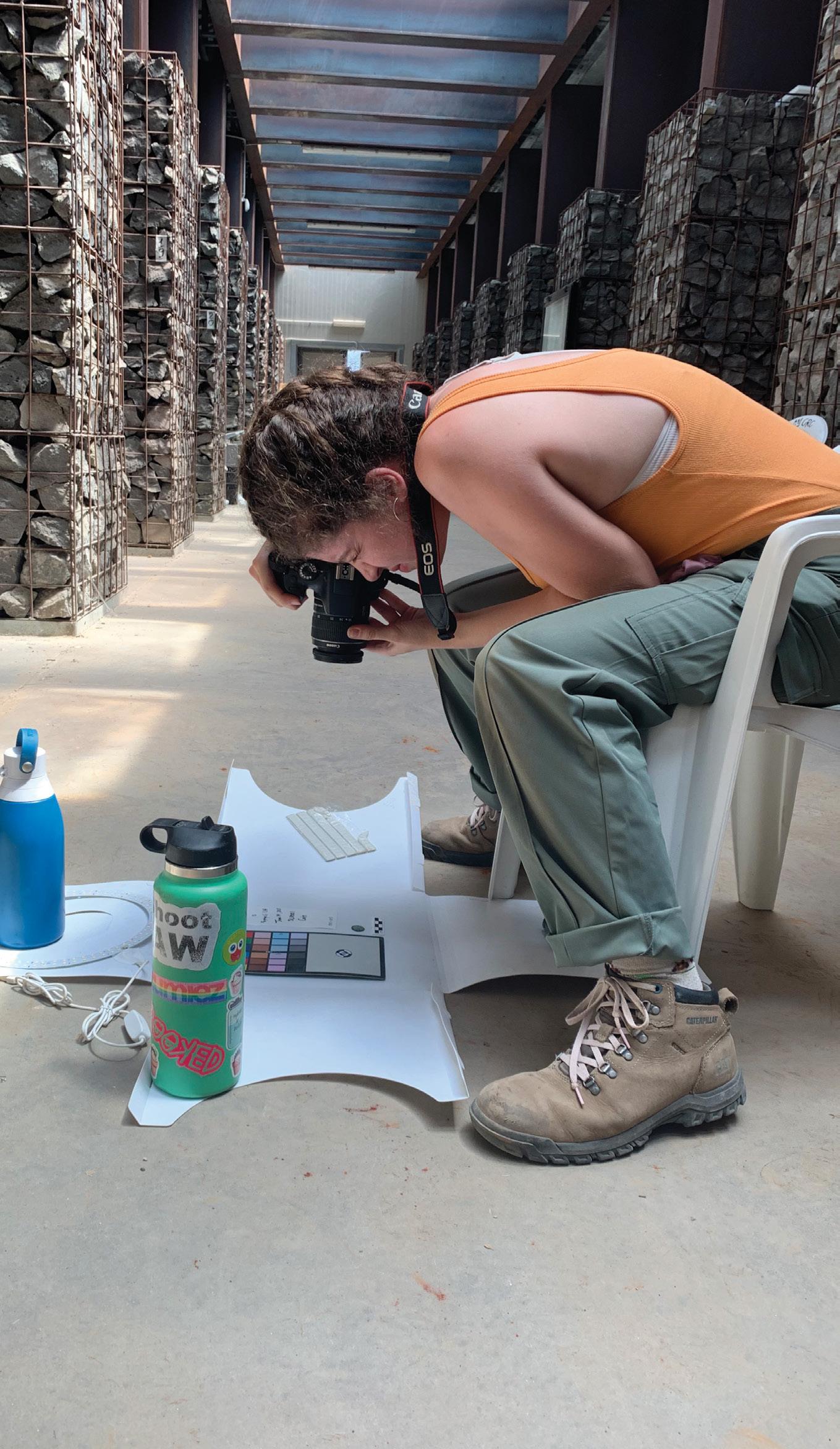
On the cover: WashU's quantum diamond microscope features nanodiamonds modified by scientists to be extremely sensitive to outside forces. Researchers are using the device for their work in quantum sensing. Read more on p. 16.
The Ampersand magazine shares stories of incredible people, research, and ideas in Arts & Sciences at Washington University in St. Louis. It is published semiannually and distributed to alumni, faculty, students, staff, and friends of Arts & Sciences.
EMAIL ampersand@wustl.edu
WEBSITE ampersand.wustl.edu
DEAN
Feng Sheng Hu
PUBLISHER
Ebba Segerberg
DIRECTOR OF MARKETING & COMMUNICATIONS
Marcia Sullivan
EDITOR
Sarah Hutchins
CREATIVE DIRECTOR
Sudon Choe
PUBLICATION COORDINATORS
Sarah Lu England, Janet Vigen Levy
DIGITAL EDITORS
Gennie Avellino, Nathan Ralph
LEAD PHOTOGRAPHER
Sean Garcia
CONTRIBUTING PHOTOGRAPHERS
Joe Angeles, Whitney Curtis, Sid Hastings
DESIGNERS & ILLUSTRATORS
Monica Duwel, Daniel Fishel, Keren Guo, Kristen Wang
CONTRIBUTING WRITERS
Shawn Ballard, Jenny Bird, Jeremy Goldmeier, Sarah Hutchins, Talia Ogliore, Sara Savat, Diane Toroian Keaggy, Josh Valeri, Chris Woolston
EDITORIAL ADVISORS
Deanna Barch, Andrew Brown, Sophia Hayes, Erin McGlothlin, Thomas Eschen, Adia Harvey Wingfield
Spring 2024
(Photo courtesy of Ana María Núñez)
2

We
are taking quantum leaps across disciplines.
What does it mean to take a quantum leap? As another academic year comes to a close, I have been reflecting on this question and the many ways Arts & Sciences is transforming the intellectual landscape of Washington University through research, education, and public impact.
This year we recruited a cohort of exceptional faculty members, paving the way for cross-disciplinary collaborations, the pursuit of new insights, and scientific breakthroughs. We celebrated a recordbreaking year for external grant funding and recently received a new grant of $19 million from the National Institutes of Health. This new grant will empower WashU to spearhead the analysis of materials related to human diseases from six clinical sites across the country (p. 7). Our students also continued to garner national recognition, including a prestigious Rhodes Scholarship (p. 6), two Gates Cambridge Scholarships, three Goldwater Scholarships, and an invitation to the White House (p. 38).
I am excited to share many of these stories in this issue of Ampersand magazine. One of our most exciting developments is the launch of the aptly named Center for Quantum Leaps (p. 16). The center’s founding members are working across disciplines to pioneer advances that could shape the future of technology, medicine, and computing. I’m eager to watch this signature initiative of the Arts & Sciences Strategic Plan position WashU — and the St. Louis community — as a leader in quantum science.
A spirit of rapid innovation is at the heart of everything we do in Arts & Sciences. Scholars in the Department of Psychological & Brain Sciences are developing and deploying cutting-edge methods for studying the inner workings of the mind, research with a direct impact on our everyday lives (p. 32). In our Performing Arts Department, ballet master Antonio Douthit-Boyd is challenging preconceived notions about classical dance (p. 12). I’m constantly impressed by the ambition and creativity of our students, some of whom are adopting a transdisciplinary mindset as they unite the arts and the sciences through a rigorous study of their favorite music genre (p. 24).
This issue also showcases the impact of our Arts & Sciences community. You will have a chance to read about our Distinguished Alumni Award winners, a group of Arts & Sciences graduates and supporters who used their education to change the world (p. 36). I hope you will also take a few minutes to help us celebrate two retiring faculty members who, through their dedication and leadership, made a lasting mark on Washington University (p. 20).
As you explore this issue, I’m sure you will come to the same conclusion I have: Arts & Sciences is taking quantum leaps. Our actions — from novel research centers to individual accomplishments — are adding up to something extraordinary. I hope you will join us on campus soon to see this exciting progress for yourself.
Warmly,
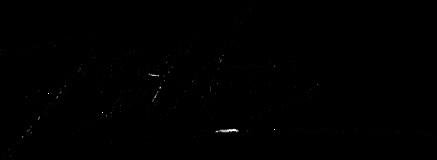 Feng Sheng Hu
Feng Sheng Hu
Richard G. Engelsmann Dean of Arts & Sciences
Lucille P. Markey Distinguished Professor
Washington University in St. Louis
The Ampersand | Spring 2024 3
Table of Contents

FEATURES
Inside WashU's quantum quest
Arts & Sciences scholars are teaming up with researchers across WashU to develop new tools to probe the fundamental forces that shape our world.
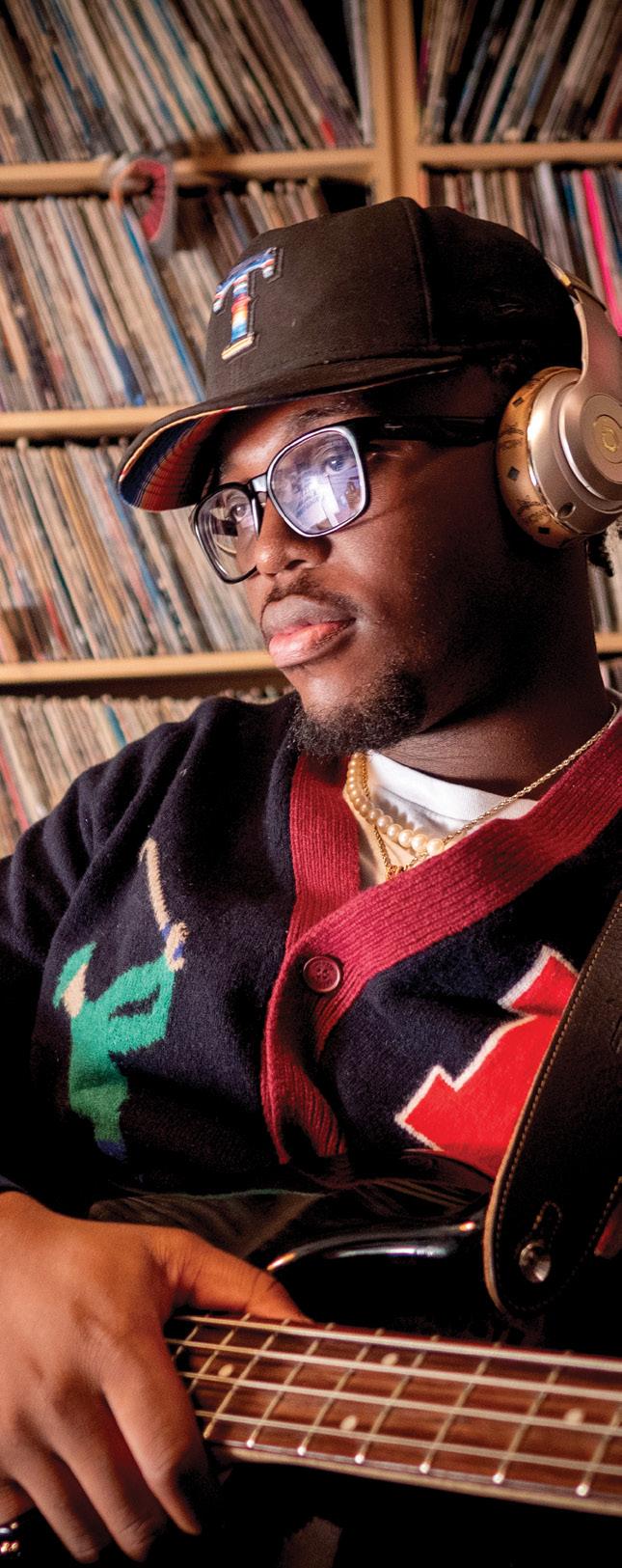

An Arts & Sciences guide to hip-hop
A popular course unites students from diverse disciplines in a rigorous study of hip-hop and rap — the predominant music of their generation.
Unlocking the secrets of the human brain
Researchers in The Department of Psychological & Brain Sciences are using cutting-edge techniques to help us weather the challenges of everyday life.
16 32
24
4
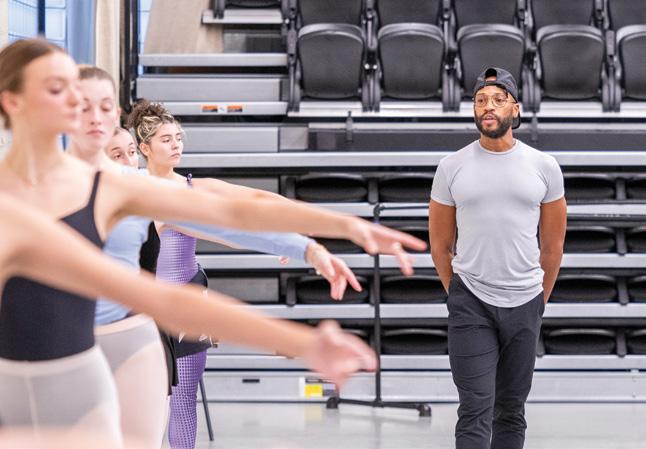
A bright future for ballet
St. Louis native Antonio Douthit-Boyd discusses the transformation of classical ballet taking place at WashU.
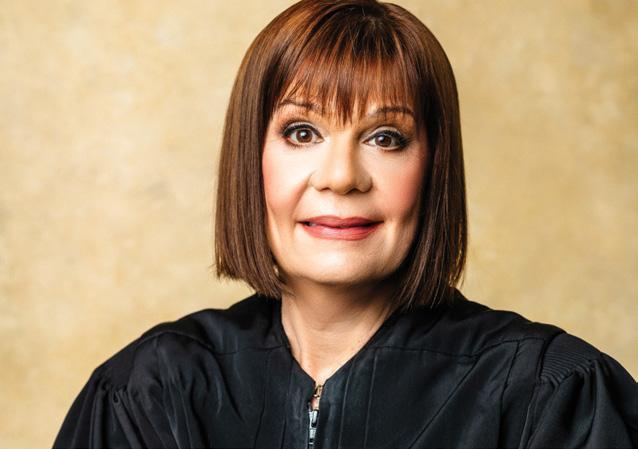
The language of the law
Camille L. Vélez-Rivé, AB ‘89, traces her skills as a federal district judge back to her time as an Arts & Sciences undergrad.

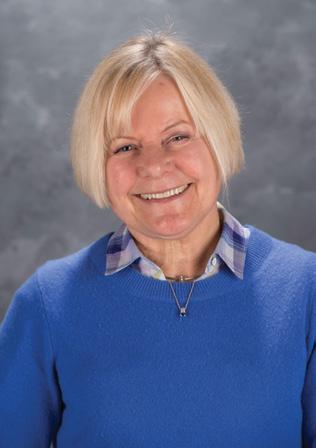
University leaders retire
James Wertsch and Gerhild Williams share highlights from decades of leadership, service, and scholarship.
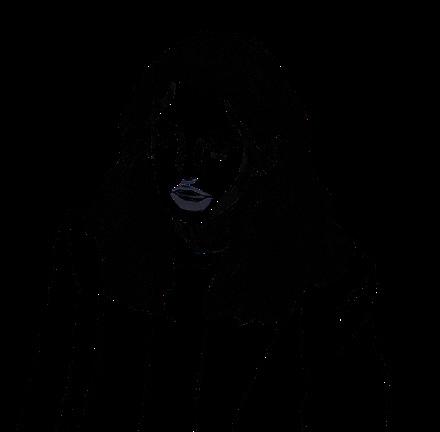
Emma Lembke logs off
The junior political science major discusses the value of a liberal arts education, her path to activism, and her invitation to the White House.
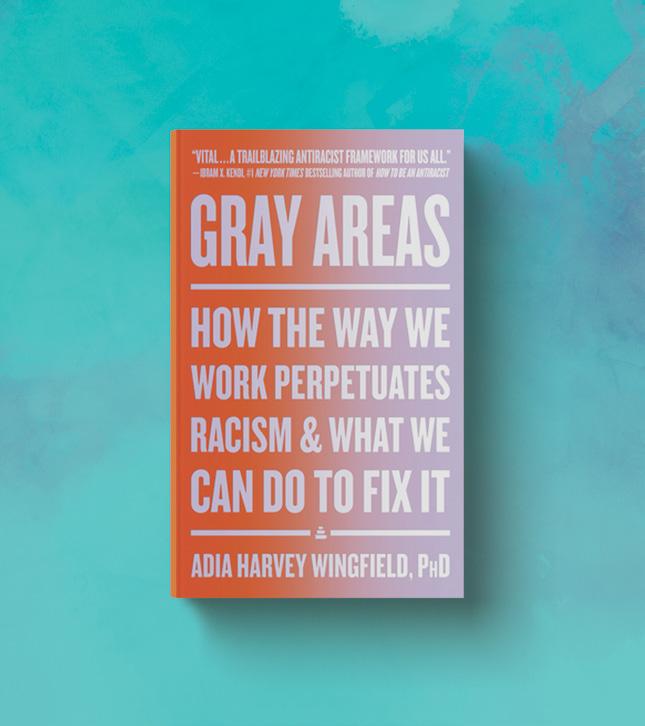
Recent faculty titles explore "gray areas" in the workplace, experimental film culture, and the global history of Chinese script reforms.
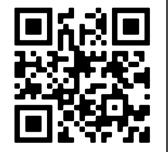
40 14 20 12 FACULTY BOOKSHELF CONVERSATION MEMORIES & MILESTONES STUDENT SPOTLIGHT ALUMNI SPOTLIGHT 38 Sunsets — and science — at sea Science for all WashU’s chemistry chair shares a formula for scientific innovation — creating a culture where diversity thrives. Distinguished Alumni Awards 30 42 36
PERSPECTIVE NOTES OF GRATITUDE Not-so-spooky sounds Tyson Research Center 7 Optimizing the ‘omics’ Department of Chemistry 7 Welcoming a prizewinning poet Department of English 9 You don’t know yak Department of Anthropology 8 ampersand.wustl.edu The Ampersand | Spring 2024 5
SNAPSHOT AROUND THE QUAD
Around the Quad
News, milestones, and spotlights from across Arts & Sciences at Washington University in St. Louis


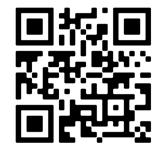
Find expanded versions of all Around the Quad stories.
artsci.wustl.edu/ATQ
The College Off to Oxford
Tori Harwell recently became WashU’s 30th Rhodes Scholar, a prestigious honor that allows students the opportunity to earn an advanced degree at the University of Oxford in England. Harwell, a senior majoring in African and African American studies and environmental analysis, wants to use her education to empower grassroots leaders to address climate change in their local communities.
“Tori is an exceptional scholar who believes in lifting up the voices of the marginalized,” said Chancellor Andrew D. Martin.
I’m proud of all Tori has already accomplished at Washington University, and I am confident she will thrive at Oxford.
(Illustration: Keren Guo)
Andrew D. Martin Chancellor
6
(Photo: Whitney Curtis)
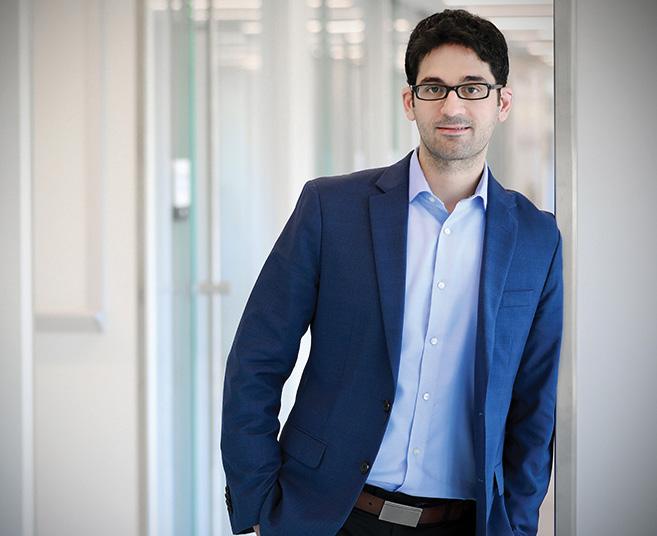
Department of Chemistry
Optimizing the ‘omics’
You might have heard of genomics, epigenomics, or metabolomics — data types that reveal distinct information about aspects of a biological system. Thanks to new technologies and data science, the connections between these many “omics” are creating a detailed picture of the factors that contribute to human health and disease.
Gary Patti, the Michael and Tana Powell Professor of Chemistry, will soon co-manage a new multi-omics production center set to analyze materials from six disease study sites across the country.
The National Institutes of Health is channeling $50.3 million into the research consortium, with WashU getting a portion valued at roughly $19.2 million.
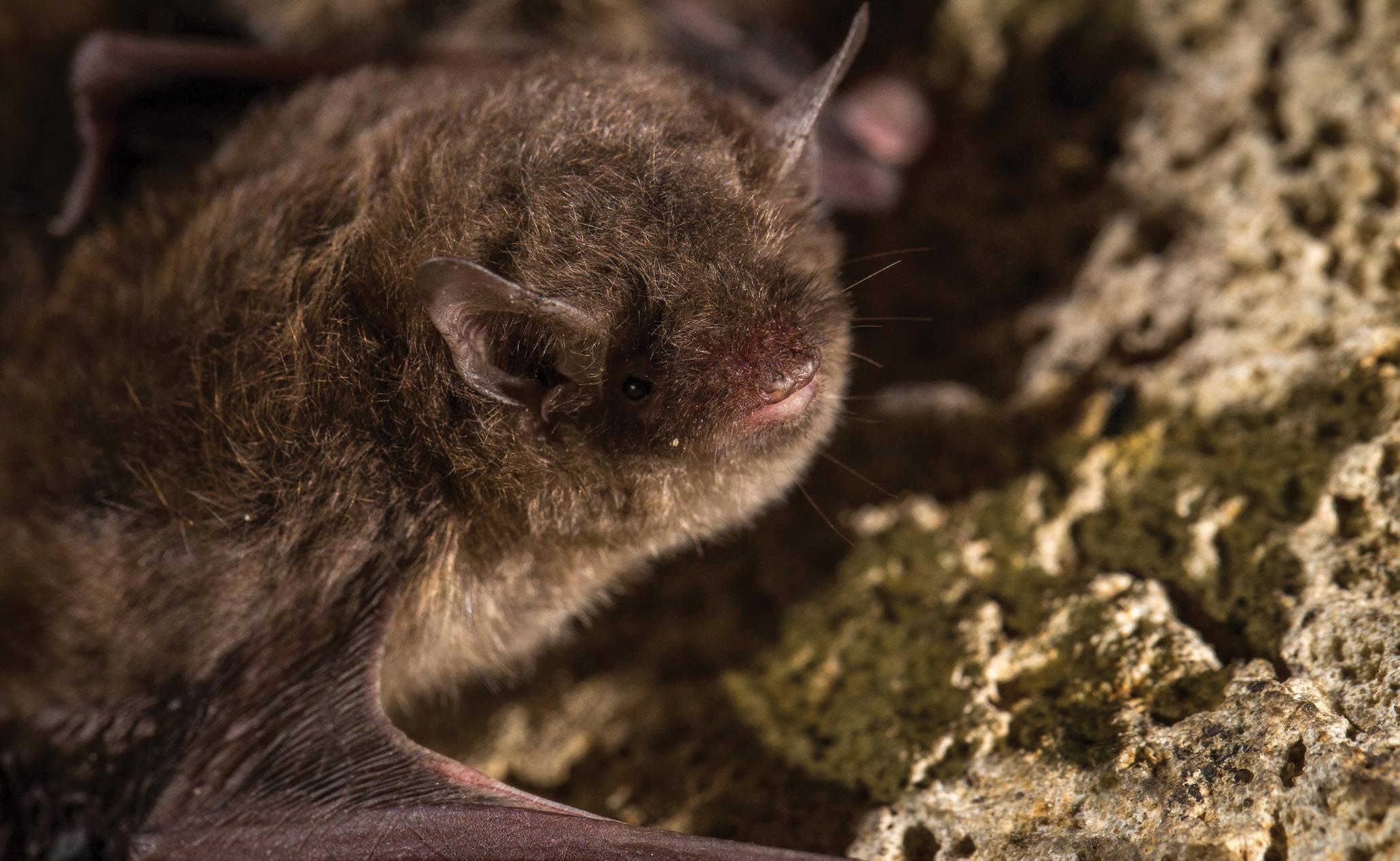
Tyson Research Center
Not-so-spooky sounds
WashU researchers working with the St. Louis Wildlife Project are using a new method to identify urban bats. In the past, scientists relied on data from motion-activated camera traps positioned in parks and on private land. Starting in 2021, they began deploying a network of Audiomoth acoustic monitors. “We’re using these little devices to record sound at the frequency of a bat call, which is higher than what humans can hear,” said Erin O’Connell, research and conservation project coordinator at Tyson Research Center. Scientists have already detected 10 species of bats in the greater St. Louis area, including several species of threatened and endangered bats.
The Ampersand | Spring 2024 7
(Photo: Ryan Hagerty, USFWS)

Department of Chemistry
Green energy guru
Doctoral student Ashlynn Berry has spent years thinking about how to make our energy system more sustainable. Berry was one of just 60 graduate students selected by the Department of Energy’s Office of Science to participate in a graduate student research fellowship. She will spend six months at Sandia National Laboratories working with renowned chemist and WashU alum Mark Allendorf, AB ’80. At WashU, Berry has been working with Bryce Sadtler, associate professor of chemistry, to develop new materials for the green production of hydrogen fuel from water — work that could support the development of gasoline alternatives for cars and trucks.
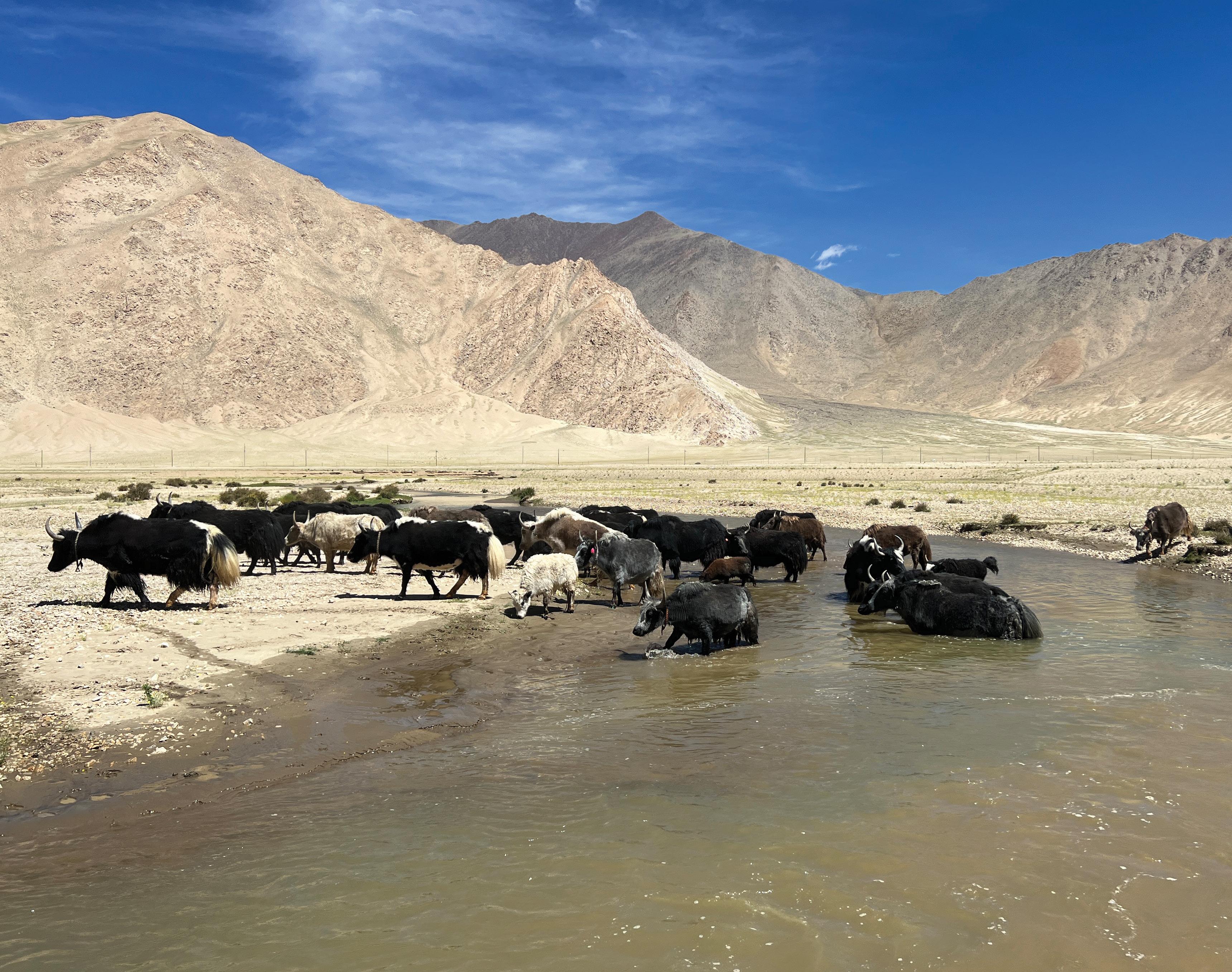
Department of Anthropology
You don’t know yak
An international team of researchers including Xinyi Liu, associate professor of archaeology, and Fiona Marshall, professor emerita and a leading expert on animal domestication, used ancient DNA and archaeology to trace the origins of domestic yak back 2,500 years. This new discovery fits into the larger story beginning to emerge about how humans adapted to living in a high-altitude environment on the Tibetan Plateau. In mountainous regions of Asia, yak and yakcattle hybrids still serve as vital sources of meat, milk, transportation, and fuel.
(Photo: Zhengwei Zhang)
AROUND THE QUAD 8
(Photo: Sid Hastings)

Department of English
Department of Germanic Languages and Literatures
A moral minefield
Erin McGlothlin, professor of German and Jewish studies and vice dean of undergraduate affairs, won the 2023 Sybil Halpern Milton Book Prize for “The Mind of the Holocaust Perpetrator in Fiction and Nonfiction.” The German Studies Association bestows the honor on the best book about Nazi Germany and the Holocaust published in the previous two years. Examining nonfictional accounts and fictionalized portraits, McGlothlin’s book analyzes troubling depictions of the inner experience of men who perpetrated genocide. She is the first scholar who is not a historian to win the prize, a reflection of the increasingly multidisciplinary character of Holocaust studies and McGlothlin’s ability to skillfully navigate moral and ethical challenges.
Welcoming a prize-winning poet
Eduardo C. Corral will join the English department this fall, adding to the MFA program’s roster of award-winning faculty. Corral’s debut poetry collection, “Slow Lightning,” was chosen by Carl Phillips, professor of English, for the 2011 Yale Series of Younger Poets prize, and his second collection, “Guillotine,” was longlisted for the National Book Award. “We have a storied, powerful MFA program with a long tradition of nationally recognized writers who draw in the best students,” said Abram Van Engen, chair of English and the Stanley Elkin Professor in the Humanities. “That tradition continues forward in the work of Eduardo C. Corral.”
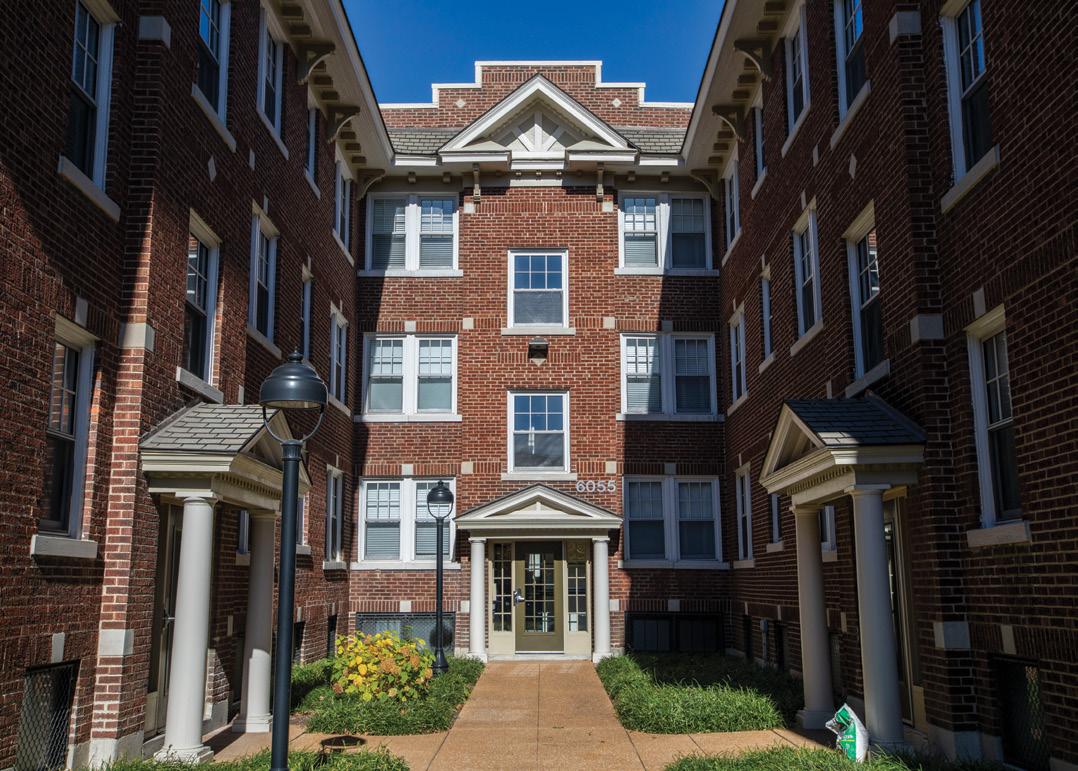
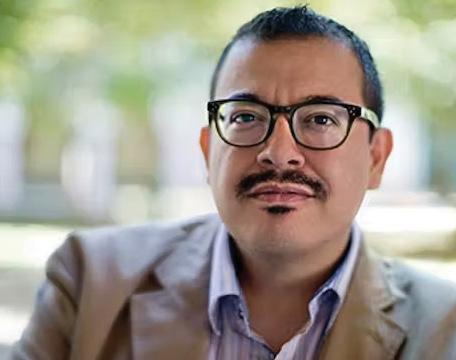
Department of Sociology
What’s in a name?
Research by Ariela Schachter, associate professor of sociology, found that many online housing listings reflect implicit biases about neighborhoods based on racial and socioeconomic factors. Analyzing more than 94,000 Craigslist rental housing ads in St. Louis City, Schachter and collaborators found that listings in neighborhoods with higher shares of poor and Black residents were less likely to include the neighborhood name. The opposite was true for areas with higher shares of college-educated residents. “The racialized (in)visibility of neighborhoods is one way the housing market both reflects and reproduces residential racial segregation and inequality,” Schachter said.
(Photo: Matt Valentine)
The Ampersand | Spring 2024 9
(Photo: Joe Angeles)
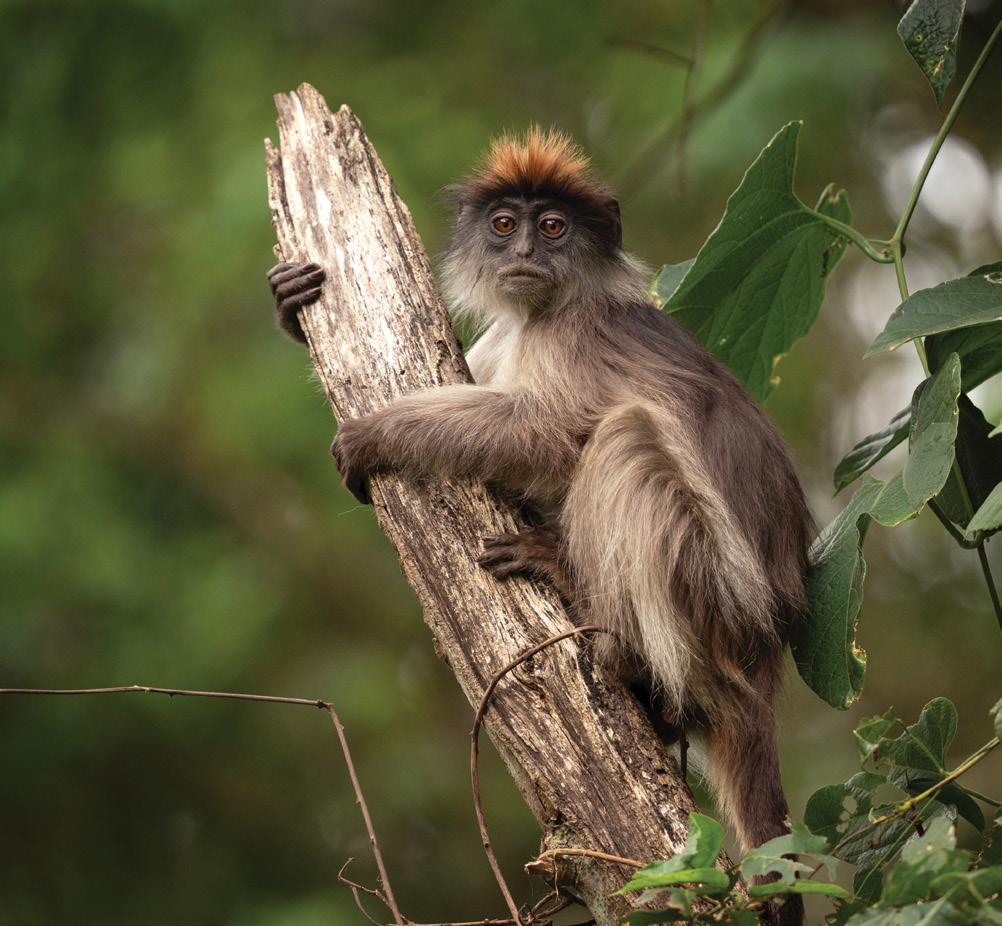
Arts & Sciences Strategic Plan Where the wild viruses are
A five-year grant from the National Institutes of Health will allow anthropologist Krista Milich, biologist Michael Landis, and virologist David Wang to model viral transmission dynamics among red colobus monkeys and their human neighbors near Kibale National Park in Uganda. Their collaboration, which includes the School of Medicine, began with a research cluster formed through the Incubator for Transdisciplinary Futures, a signature initiative of the Arts & Sciences Strategic Plan. The team is focused on identifying scenarios likely to promote infectious diseases within and between animal species. The new funding will expand their work and tap into Milich’s long-running research program at Kibale.
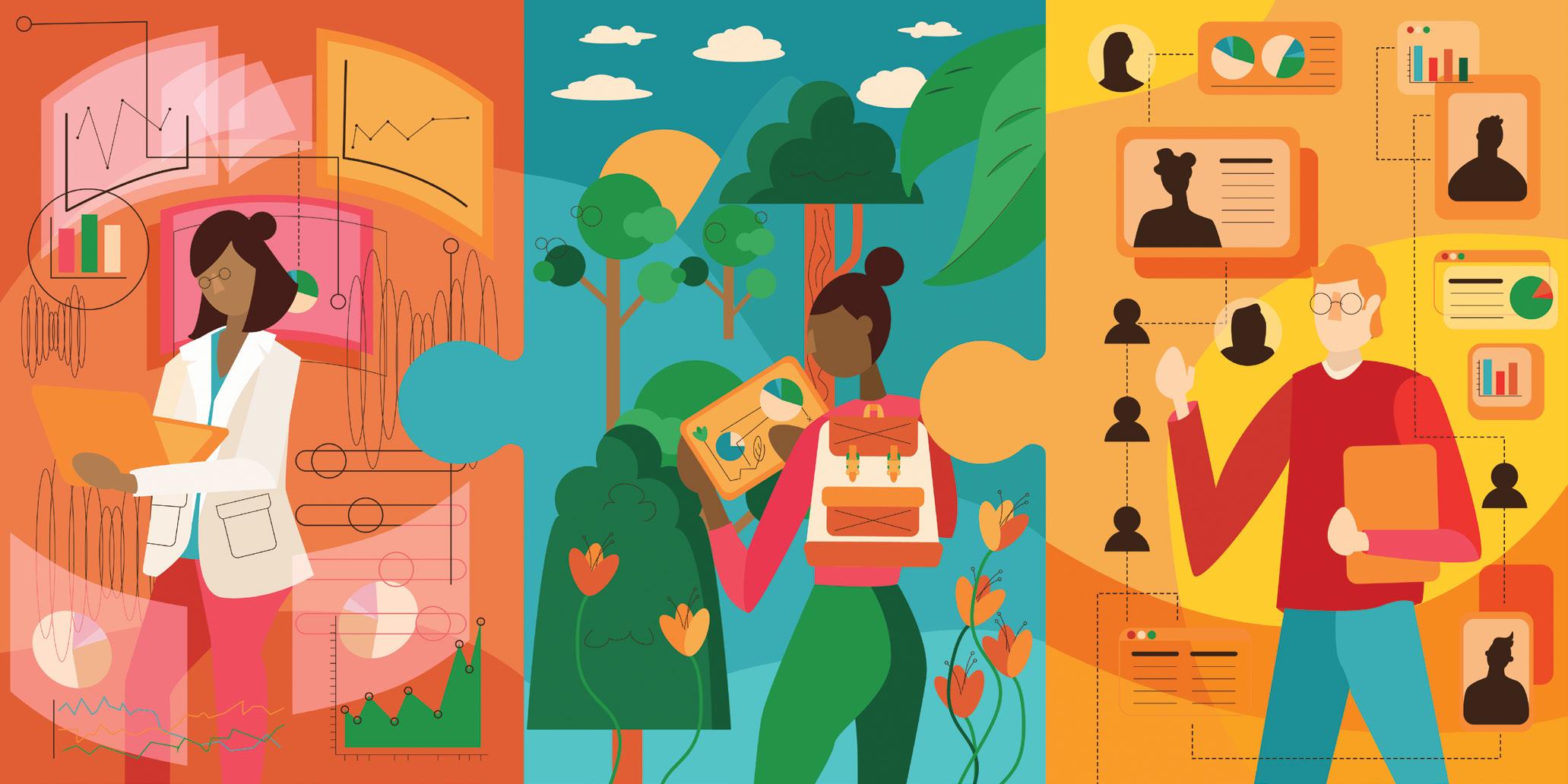
Training investigators in AI
The National Science Foundation is investing $3 million over the next five years in WashU’s AI-ACCESS research traineeship program. The initiative aims to build a cohort of investigators educated at the intersection of AI, environmental science, and social science who can harness innovative computational tools to address global challenges such as climate change. Claire Masteller, assistant professor of Earth, environmental, and planetary sciences, will serve as co-principal investigator of the program, which includes collaborators in the McKelvey School of Engineering and the Brown School.
Department of Earth, Environmental, and Planetary Sciences
AROUND THE QUAD 10
(Illustration: Monica Duwel)
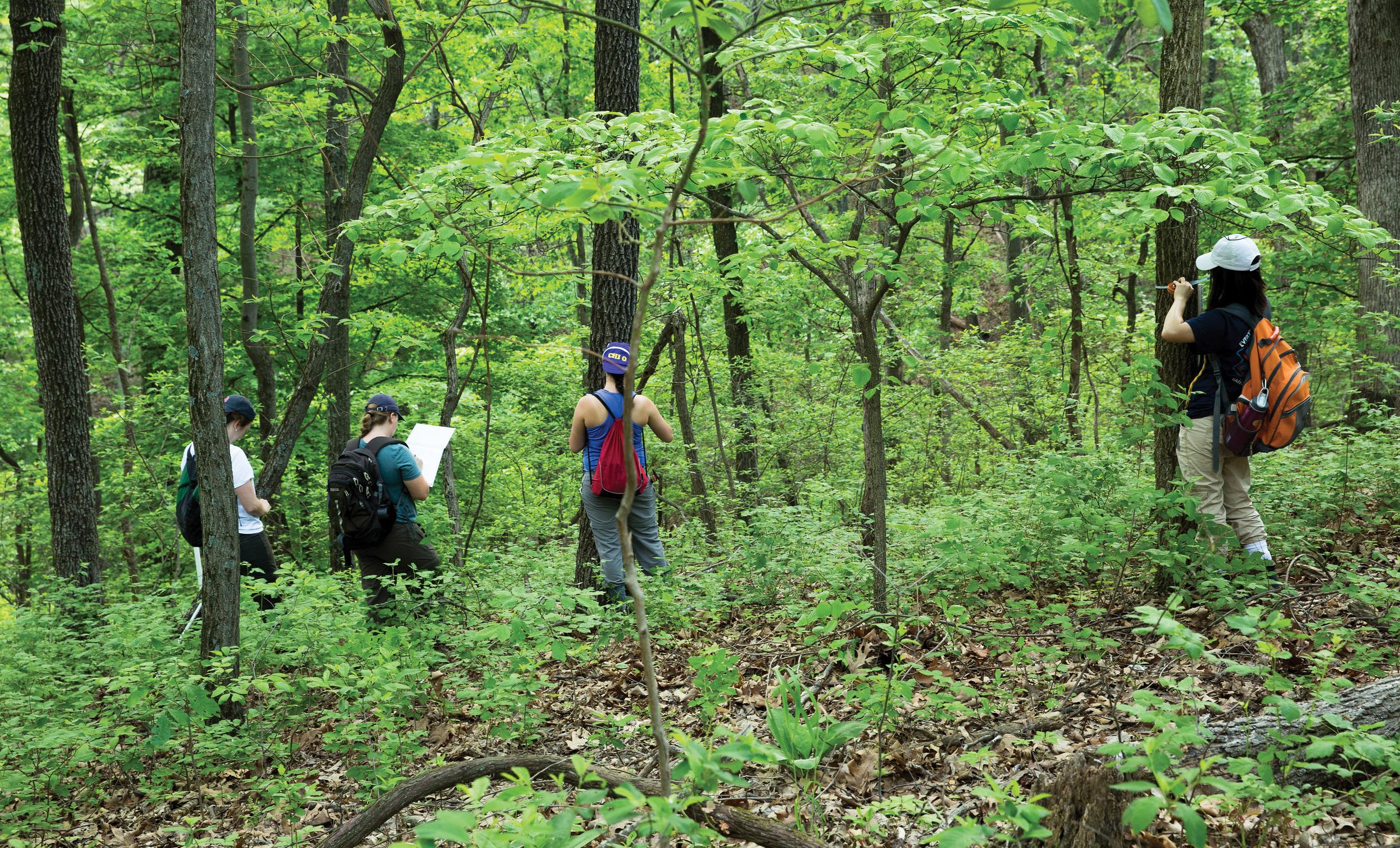
Department of Biology
Roots of diversity
A study involving 43 research plots in the Forest Global Earth Observatory network — including a swath of trees at WashU’s Tyson Research Center — fueled a global investigation into the power of underground fungi to shape forests. From the tropics to the far north, fungi in the soil help determine the number and types of trees that can thrive in any given area, said Jonathan Myers, associate professor of biology. “The study really zeroed in on one of the basic patterns in ecology, which is that forests become more diverse the closer you get to the equator,” Myers said.
Department of Political Science
Symbolic speech
Black legislators talk about race and civil rights more than their white colleagues, and they often rely on powerful symbolism to connect with constituents, according to new research by Matthew Hayes, associate professor of political science. In an analysis of nearly 800,000 U.S. House of Representatives floor speeches given between 1996 and 2014, Hayes found Black members of Congress talk about civil rights 15 times more often than white representatives. Black legislators were also more than twice as likely to invoke issue-based symbolism — such as Martin Luther King Jr. or the Stonewall uprising — when discussing civil rights.
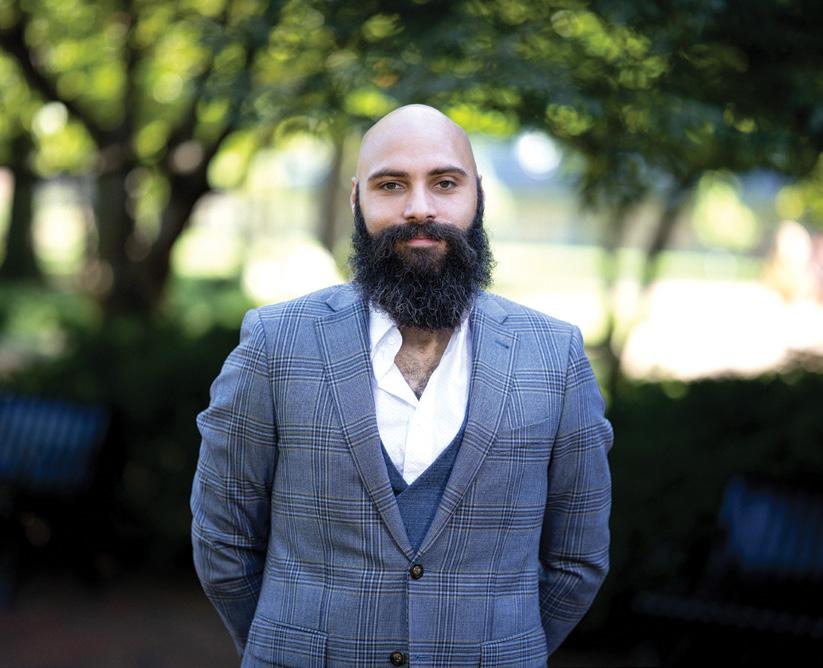
The Ampersand | Spring 2024 11
A bright future for classical ballet
St. Louis native Antonio Douthit-Boyd is breaking down barriers to ballet and finding new ways to bring dance into the community.
 by JENNY BIRD
by JENNY BIRD
After moving to New York City in the early 2000s to pursue a career in dance, Antonio Douthit-Boyd never thought he’d find himself back in his hometown of St. Louis. When he returned to the Midwest almost a decade ago, however, he found himself working as a professor of practice in WashU’s Performing Arts Department and serving as artistic co-director of dance at the nearby Center of Creative Arts (COCA). Today he’s WashU’s full-time ballet master.
Douthit-Boyd sat down with the Ampersand to talk about his journey, his dance philosophy, and the future of classical ballet at WashU.
CONVERSATION 12
Tell us about your dance journey from St. Louis to New York and back.
I came to dance at the age of 16, which is quite late. I was walking with a group of friends in downtown St. Louis when we heard drums coming from a building. We went inside and found Angela Culbertson of aTrek Dance Collective holding a class. She let us stay and invited us back for another class. Angela saw promise in me and called Dance St. Louis, which sent me to COCA. I grew up in north St. Louis in a very lowincome neighborhood where opportunities were hard to find, but people saw talent in me and mentored me.
I got a college scholarship for dance but later left for New York City, where I became a soloist with Dance Theatre of Harlem. After that, I became a principal dancer at Alvin Ailey
How has WashU’s program changed since you’ve been here?
In the eight years since WashU added a Master of Fine Arts in Dance, we’ve come a long way in putting the program on the map. If you have a love of the arts and are also strong academically, WashU is the place to be. I think WashU is now running with some of the top dogs in the performing arts.
The number of dance majors has grown since I came to WashU in 2016. When Kirven and I joined the department along with faculty members Cecil Slaughter, David Marchant, and Joanna Dee Das, we agreed all dancers — regardless of their major or skill level — should receive high-quality training. This ensures they have the skills and knowledge to make informed decisions about pursuing dance after their time at WashU while still nurturing their passion for the art form. Now, many of our students are finishing the program and going to New York and elsewhere to become professional dancers.
I want my students to feel as though dance is something that can push past the hardships in life.
American Dance Theater, where I toured for almost 13 years. That’s where I met my husband, Kirven Douthit-Boyd, who was also an Ailey dancer and is now artistic director at The Big Muddy Dance Company.
When I introduced Kirven to St. Louis, he fell in love with the town. For 10 years, we came back every summer for two weeks to teach dance at COCA. When it came time for us to step away from performing, teaching was a natural next step.
What’s your philosophy as a dance teacher?
It can be a challenge when you have different levels of students in the same class, but I try to teach to the level of the most advanced student while meeting each person where they are. At this time in our society and in our world, students need an outlet. I want my dancers to feel as though dance is something that can push past the hardships in life. The arts can be a healing balm.
What does the future of classical ballet look like?
In the past, ballet has been pigeonholed with a museum vibe, as though it’s something only a certain kind of person can do. I love ballet and it’s brought me to where I am today, but there have been issues with the art form. It has not always been accessible to certain body types, and it’s a very expensive sport. We are breaking down some of those barriers and stereotypes at WashU.
Part of breaking down barriers to access means taking ballet out of the museum and into the community. WashU is poised to do that through outreach programs like the Spring to Dance Festival, which brings dance to more people. I’m also teaching a class this semester to help dance students learn how to be better teachers and young artists so they can inspire others in the community.
I think the future of classical ballet in general, but especially at WashU, is extremely bright. Having an African American male at the helm of WashU’s ballet program helps, as does having dancers willing to voice their opinions about traditional views around ballet and what a new ballet aesthetic could and should be. Breaking down these traditions in an academic setting helps move the art form in a whole new direction — I think for the better.
The Ampersand | Spring 2024 13
The language of the law
What does it take to become a federal district judge and the longest-serving female U.S. magistrate judge in the District of Puerto Rico? For Camille L. Vélez-Rivé, AB ‘89 , many skills can be traced back to her time as an Arts & Sciences undergrad.
by JENNY BIRD
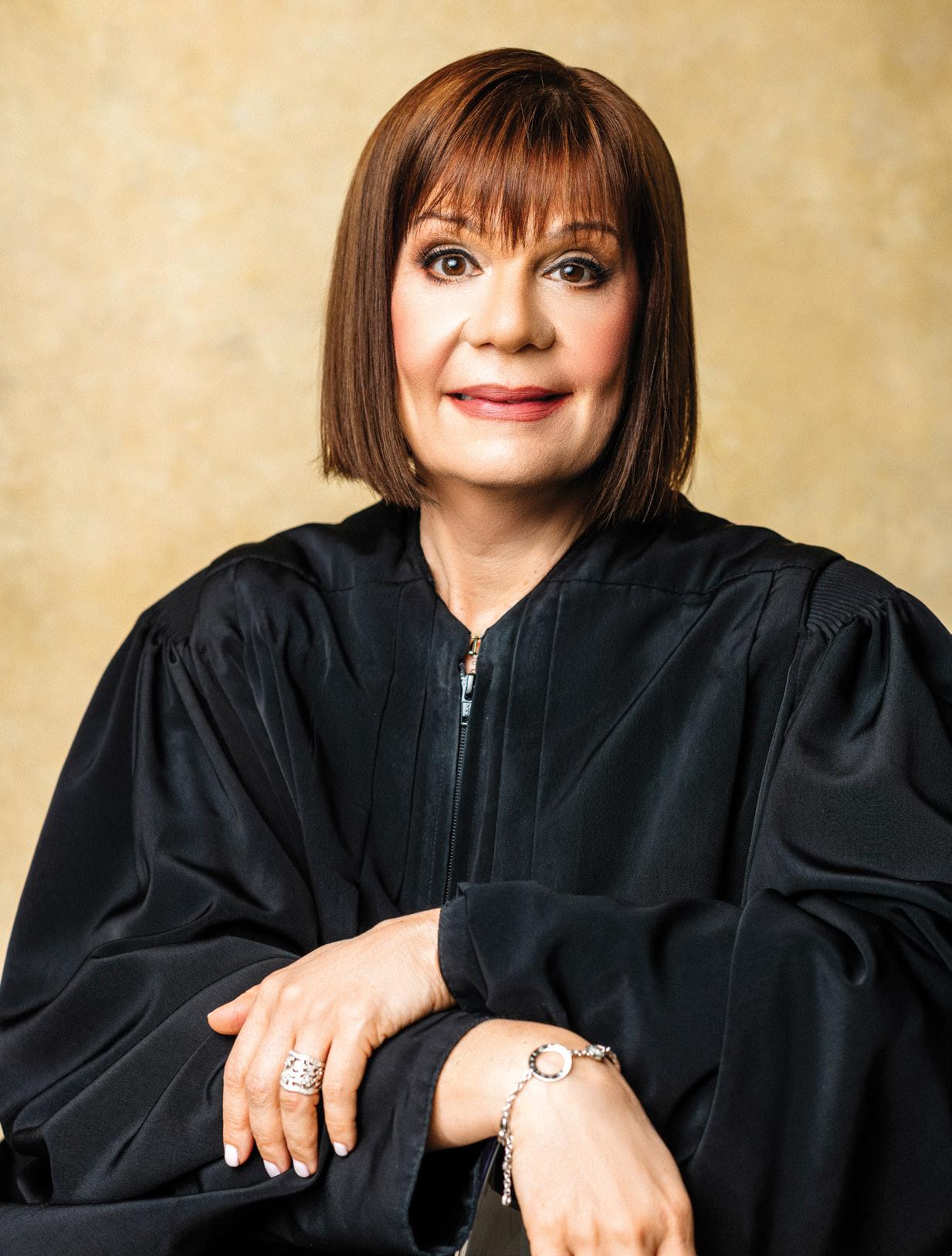
Camille L. Vélez-Rivé first learned of WashU as a child in Puerto Rico. Her father, Dr. Enrique Vélez-García, was admitted to the Barnes-Jewish Hospital training program in 1960 for his medical internship, residency, and fellowship, and the family lived in St. Louis while he studied. She said it was unusual in those days for someone from the island to train at WashU.
“My father became the first licensed hematologist and oncologist in Puerto Rico, and, in that way, his education at WashU not only had a huge impact on our family but on Puerto Rico as well,” she said.
When it came time for Vélez-Rivé and her twin sister, Lizette, to choose a university, they followed in the footsteps of their father and older brother, Enrique, who’d headed to St. Louis three years earlier to study on the Danforth (then Hilltop) campus.
The Hon. Camille L. Vélez-Rivé, United States District Judge for the District of Puerto Rico. (Photo: Ivonne Carlo)
ALUMNI SPOTLIGHT 14
By then, Vélez-Rivé was already learning her third language. She grew up speaking Spanish at home, learning English in school, and was introduced to French as a young girl by her father. WashU offered a study abroad program that allowed students to spend a year in Paris, which appealed to VélezRivé and her sister, who also attended WashU.
A French major with a business minor, Vélez-Rivé said the patience and persistence she needed to become proficient in a third language — including writing a thesis in French while studying abroad — were some of the key skills she needed to become a judge. Her language training also taught her to listen and consider things from diverse perspectives, an essential ability when hearing two sides of an argument in a courtroom.
She also credits her time in St. Louis and Paris with nurturing her independence, a critical trait for a judge. “Judicial independence means you have to persevere,” she said. “You have to be very sure of yourself without being influenced by anyone.”
From WashU, Vélez-Rivé returned to Puerto Rico for law school. After clerking for now-retired Puerto Rico Supreme Court Associate Justice Francisco Rebollo-López, she went into private practice and worked in civil litigation. Like her father, whose work improved public health across the island, Vélez-Rivé ultimately decided she wanted to give back as a public servant. She became an assistant U.S. attorney in Puerto Rico, doing several years of criminal appellate work before moving to the civil division.
In 2004, Vélez-Rivé was appointed a U.S. magistrate judge, a position she occupied for more than 18 years — the longest a female judge in Puerto Rico has held that role. In December 2022, President Biden commissioned her as a federal district judge, making her the fifth woman in Puerto Rican history to receive the honor.
“Success for me did not happen from one day to the next,” she said. “It took many years of hard work, sacrifices, and overcoming obstacles in both my personal and my professional lives to get to where I am today.”
Those challenges included navigating her two-year-old daughter’s leukemia diagnosis and treatment right after she was appointed magistrate judge. “One thing I am very proud of is that I was able to balance my personal life with my professional life,” she said. “I was able to do everything. I don’t know how, but I’m very proud of that.”
Today, the family’s WashU legacy continues. Vélez-Rivé’s daughter María Elisa Aguiló is now an Arts & Sciences undergraduate studying cognitive neuroscience and Italian. Vélez-Rivé is pleased her daughter has found a home in the same rich learning environment that nurtured her family over the decades.
“As good as the WashU education was 35 years ago, I think it’s even better today,” she said. The diversity of the Arts & Sciences curriculum provided an ideal launching pad for a career in public service. “I had a very well-rounded education that gave me the tools and knowledge to succeed in law.”

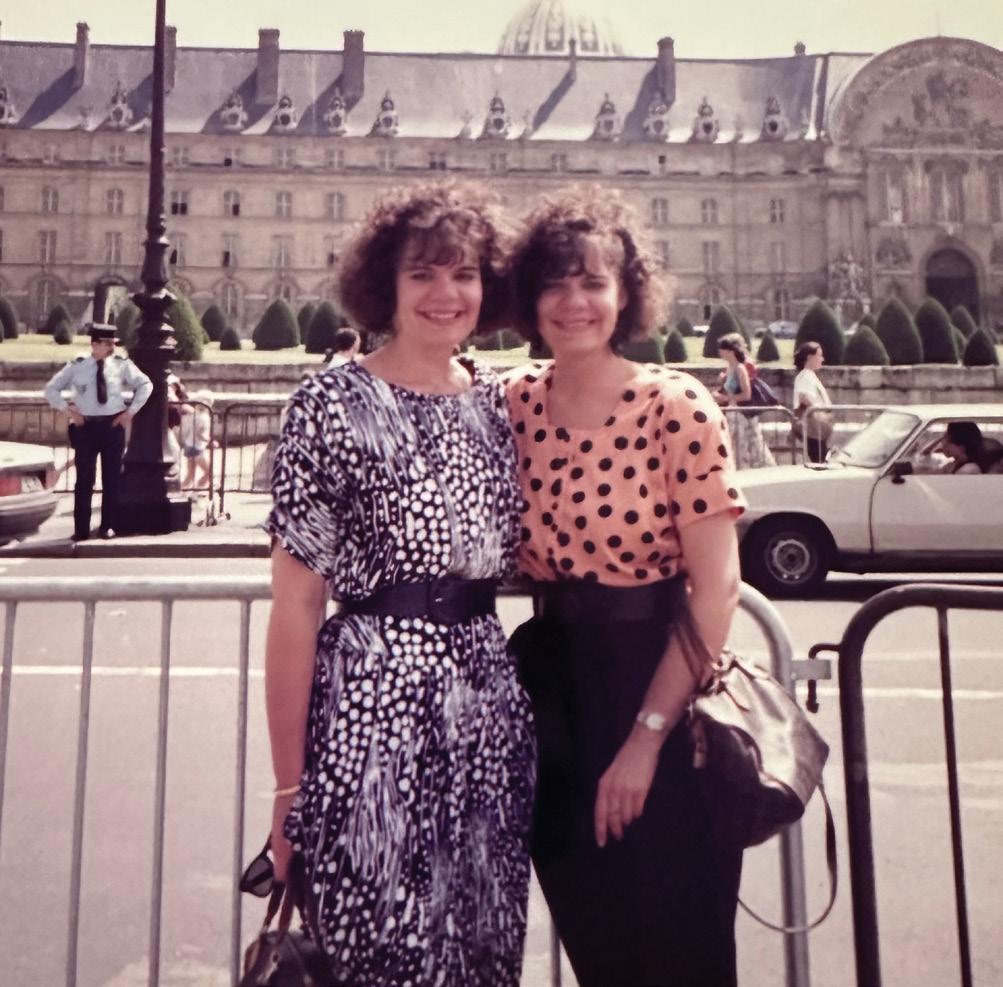 Top: Veléz-Rivé (right) with her daughter, María Elisa Aguiló (left), and her twin sister Lizette C. Veléz-Rivé (center) on the WashU campus.
Top: Veléz-Rivé (right) with her daughter, María Elisa Aguiló (left), and her twin sister Lizette C. Veléz-Rivé (center) on the WashU campus.
The Ampersand | Spring 2024 15
Bottom: Veléz-Rivé (left) with her twin sister, Lizette, during their study abroad year in Paris.
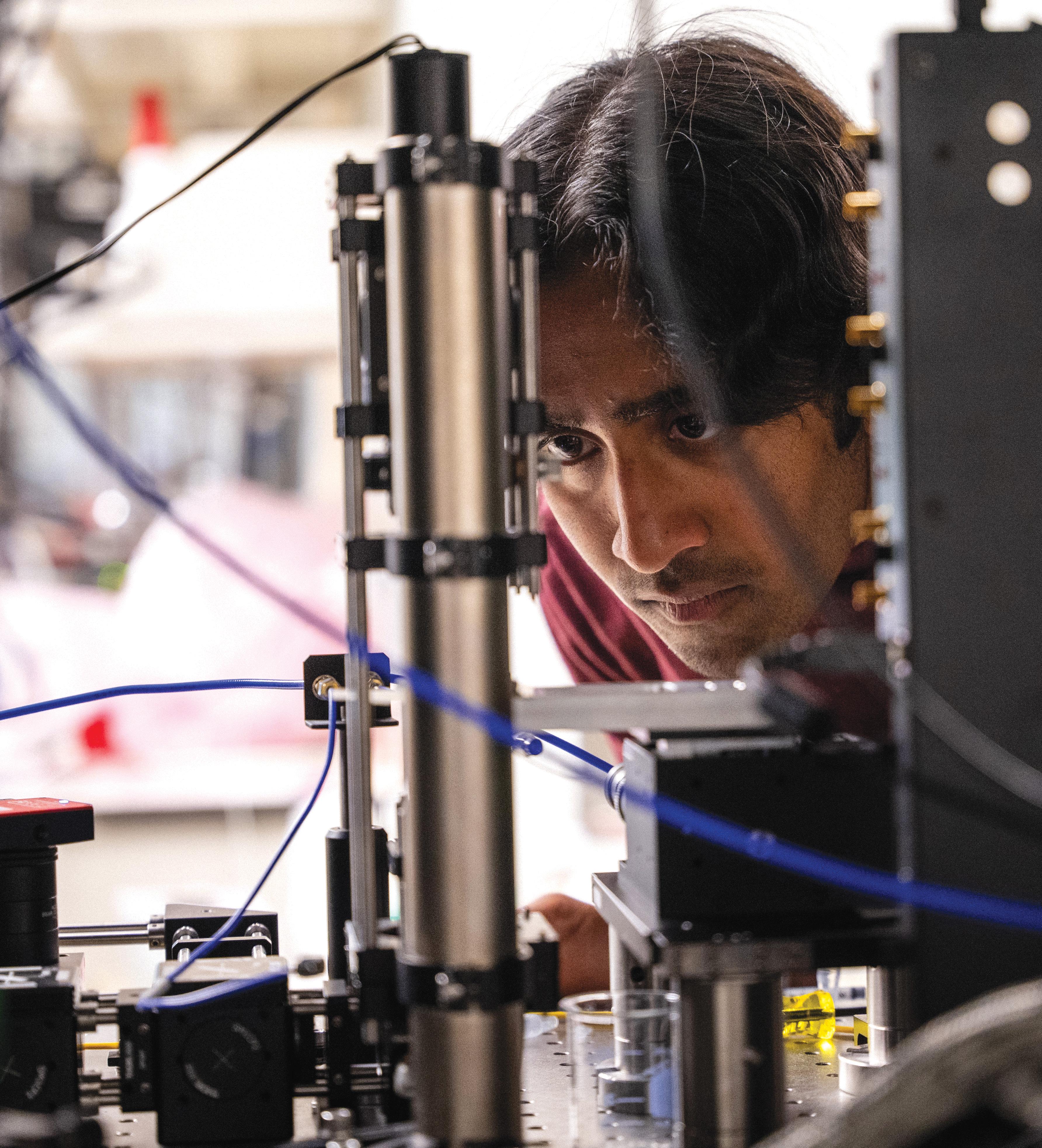
Inside WashU’s Quantum Quest
Arts & Sciences scholars are teaming up with researchers across WashU to develop new tools to probe the fundamental forces that shape our world.
by CHRIS WOOLSTON
FEATURES 16
(Photos: Sean Garcia)
Quantum is a fascinating (if a bit mysterious) field that unites scholars across the natural sciences. While much of quantum science remains fantastical and futuristic, WashU researchers are already establishing themselves as pioneers in the field. Their quantum-powered advances — microscopes that can “see” magnetic fields and other properties, and diamond sensors that can track the most basic activities of living cells — could transform many areas of science and society.
“We’re working across disciplines and finding exciting new places to employ quantum technologies,” said Kater Murch, the Charles M. Hohenberg Professor of Physics.
We asked some of WashU’s brightest minds to tell us about their work and how it's shaping the future.
What is quantum science?
Quantum research investigates the stuff that happens at the super-small scale, such as the forces between atoms and the behavior of electrons. At this level, nature often acts in ways that strain comprehension — even for scientists!
Here’s one example: quantum physics tells us light and matter take forms that are both particles and waves, an impossibleto-visualize dual existence that can only be described by math.
“Quantum science seems magical because it defies our experience of the world,” said Sophia Hayes, professor of chemistry.
Where is quantum research happening at WashU?
Much of the quantum research at WashU is taking place through the Center for Quantum Leaps, a signature initiative of the Arts & Sciences Strategic Plan. Launched in 2022 after years of planning, the CQL is working to pursue novel research in the areas of astrophysics, quantum devices, and quantum computing algorithm development. To create this quantum powerhouse, the university recruited some of the top scholars in the field and gave them the resources they needed to pursue groundbreaking science.
“The Center for Quantum Leaps is positioning WashU to be at the forefront of quantum research,” said Feng Sheng Hu, the Richard G. Engelsmann Dean of Arts & Sciences. “Our exceptional scholars are collaborating to pursue novel lines
of inquiry that will profoundly reshape our knowledge and application of science, medicine, and technology.”
Because quantum science can be applied to so many fields, Arts & Sciences researchers frequently collaborate with the School of Medicine, the McKelvey School of Engineering, and the McDonnell Center for the Space Sciences.
“The collaborative culture of WashU makes it an ideal environment for quantum advances,” Murch said.
What are some potential applications of quantum science?
WashU scientists are focusing on three game-changing uses of quantum science: sensing, computing, and, eventually, communication.
Researchers have already made great strides in pushing the boundaries of quantum sensing. Using various devices and approaches, they can harness quantum phenomena to measure and detect novel properties of atoms and molecules in anything from a rock to a human cell. These technologies allow scientists to see infinitesimal properties that would be invisible to even the most powerful conventional microscopes.
“Everybody agrees quantum sensing is going to provide transformative advantages,” Murch said. “We just have to find the right ways to use it and do the engineering to make it possible.”
What kinds of devices are used for quantum sensing?
Ever heard of a microscope powered by diamonds? WashU has two. Chong Zu and Shankar Mukherji, both assistant professors of physics, helped build one of the university’s quantum diamond microscopes, cutting-edge devices using quantum principles to offer insights far beyond the reach of typical optical microscopes.
The WashU-built microscope, completed in spring 2023, features nanodiamonds that scientists blasted with beams of nitrogen. These rays knock out atoms of carbon, leaving vacant spaces in the diamond that quickly fill with electrons extremely sensitive to outside forces, including temperature and magnetism. By tracking how the electrons in the nanodiamond respond to their environment, researchers can
The Ampersand | Spring 2024 17

see the world with new levels of precision. “You can get images of magnetic fields at a nanoscale, which is unique,” Zu said.
Lan Yang, the Edwin H. & Florence G. Skinner Professor of Electrical and Systems Engineering in the McKelvey School, has published more than 100 technical papers and received 11 patents for her work in photonics, the study of light. Her research centers around the fundamental understanding of interactions between light and matter at ultrasmall (nanometer and micrometer) scales. Her team is developing innovative devices and systems that can harness the quantum nature of light to achieve a new class of sensors.
One of Yang’s inventions is an optical sensor that can detect and trap beams of light into a device smaller than a human hair. She calls the sensors “whispering galleries” because light moves inside the devices much like sound travels along
the curved ceilings of a cathedral, where even faint whispers are amplified.
Yang’s technology could be useful for communication that uses light to carry information. It also has the power to detect tiny airborne particles by collecting reflected light, an application with major implications for environmental monitoring and public health. Her team has already shown the sensor’s ability to detect airborne flu viruses, and she said portable biosensors might be able to eventually warn of invisible viruses and other threats.
Erik Henriksen, associate professor of physics, builds quantum-enabled sensors using atomically thin materials that can measure across vastly different scales, up to and including the movement of the planet.
Henriksen is part of a team that received a National Science Foundation award that seeks to create a quantum sensor based on 2D materials suspended in liquid helium. The supersensitive device should be able to detect minute changes in the Earth’s rotation and allow for navigation without relying
How is quantum advancing medical research?
David Piston, co-director of the Center for Quantum Leaps, is leading the effort to integrate quantum sensing into medicine. To do this, he and other researchers are attempting to insert nanodiamond sensors into living cells, a process that could allow for dynamic imaging of never-beforeseen biological processes. “Whenever you’re trying to do something smaller, better, and faster, a quantum approach can be very effective,” said Piston, the Edward J. Mallinckrodt, Jr. Professor and Head of Cell Biology & Physiology.
A renowned expert in diabetes research, Piston is especially interested in the flow of energy in and out of cells. His work gets to the very essence of what drives our bodies. Specifically, he’s looking at the mitochondria in human cells that work to convert glucose and fat into the energy compound ATP. The body’s cellular machinery must heat slightly for this process to work, a temperature change too subtle for conventional probes and thermometers. That’s where quantum sensing comes in.
By collaborating with Chong Zu in the physics department, Piston has been making progress on a key research challenge: finding the best way to get a super-sensitive quantum sensor
FEATURES 18
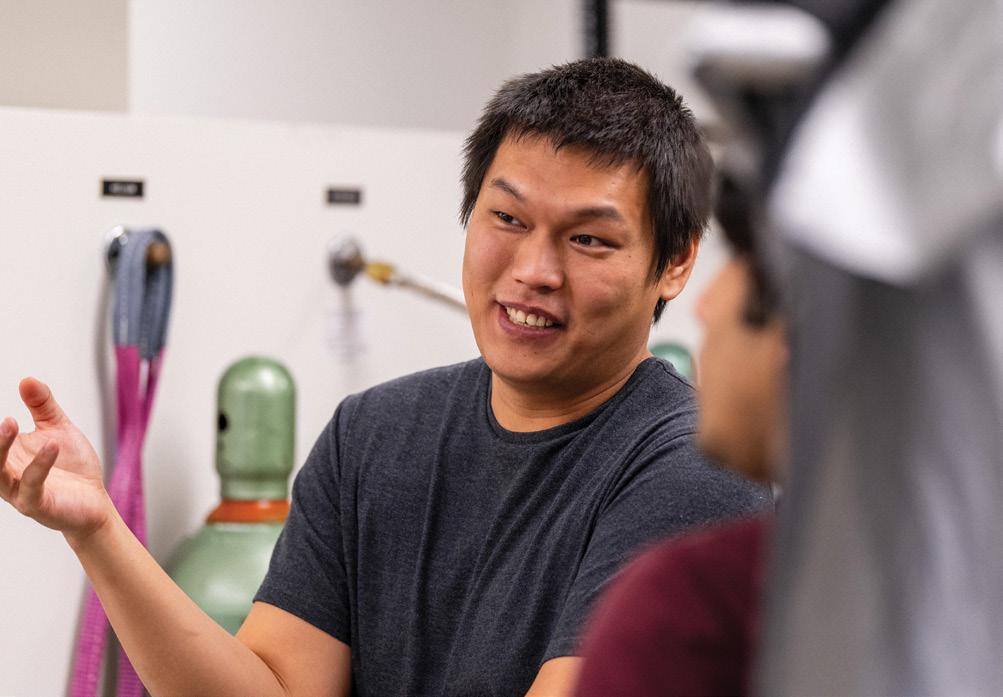
into a human cell. “We can put the cells into a liquid and add a few nanodiamonds,” he said. “If we perturb the cells either by a poke or a little electrical pulse, some of the nanodiamonds will be taken into the cells.”
Early experiments have been promising, he said, but it will take more testing to insert the diamond sensors in a way that targets key parts of a cell. If they can, one potential application of this work could be a deeper understanding of how different chemicals affect mitochondria, which, in turn, could improve treatments for diabetes and obesity.
What is quantum computing and how is WashU involved in its development?
Quantum computing refers to new technologies that could shatter our current limits on power and speed by using the quantum properties of particles — instead of electrical impulses — to code and carry information. Here are a few examples of how Arts & Sciences researchers are pursuing this critical work.
– Kade Head-Marsden, an assistant professor of chemistry hired in 2022 as part of Arts & Sciences’ Digital Transformation Initiative, is exploring the use of quantum computers to solve challenging problems in quantum chemistry.
– Sheng Ran, assistant professor of physics, won a prestigious National Science Foundation CAREER grant last year to support his quest to create new materials that could be used for quantum computing and electronics.
– Ran and Murch also won an internal Arts & Sciences SPEED grant to fund their initial work building a quantum computer powered by a new superconductor — first described by Ran and others in 2019 — containing uranium and tellurium.
Will WashU’s quantum research have a direct impact on St. Louis?
Yes. A team of WashU scientists — Kater Murch, Sophia Hayes, and Erik Henriksen of Arts & Sciences and Sheretta Butler-Barnes of the Brown School — received a $3 million grant from the National Science Foundation to create a graduate student training program for aspiring scientists and educators who want to explore careers in quantum sensing.
The program, Linking Quantum Sensing Technologies across Disciplines, will connect quantum-minded researchers at St. Louis-area companies with educators at WashU, the University of Missouri-St. Louis, Saint Louis University, and Harris-Stowe State University to develop a network of experts who can make St. Louis a national leader in quantum sensing.
The goal, Hayes said, is to build a diverse, quantum-technology-enabled workforce that can lead innovation in St. Louis and beyond.
Chong Zu, assistant professor of physics, frequently collaborates with faculty across WashU on quantum research.
The Ampersand | Spring 2024 19
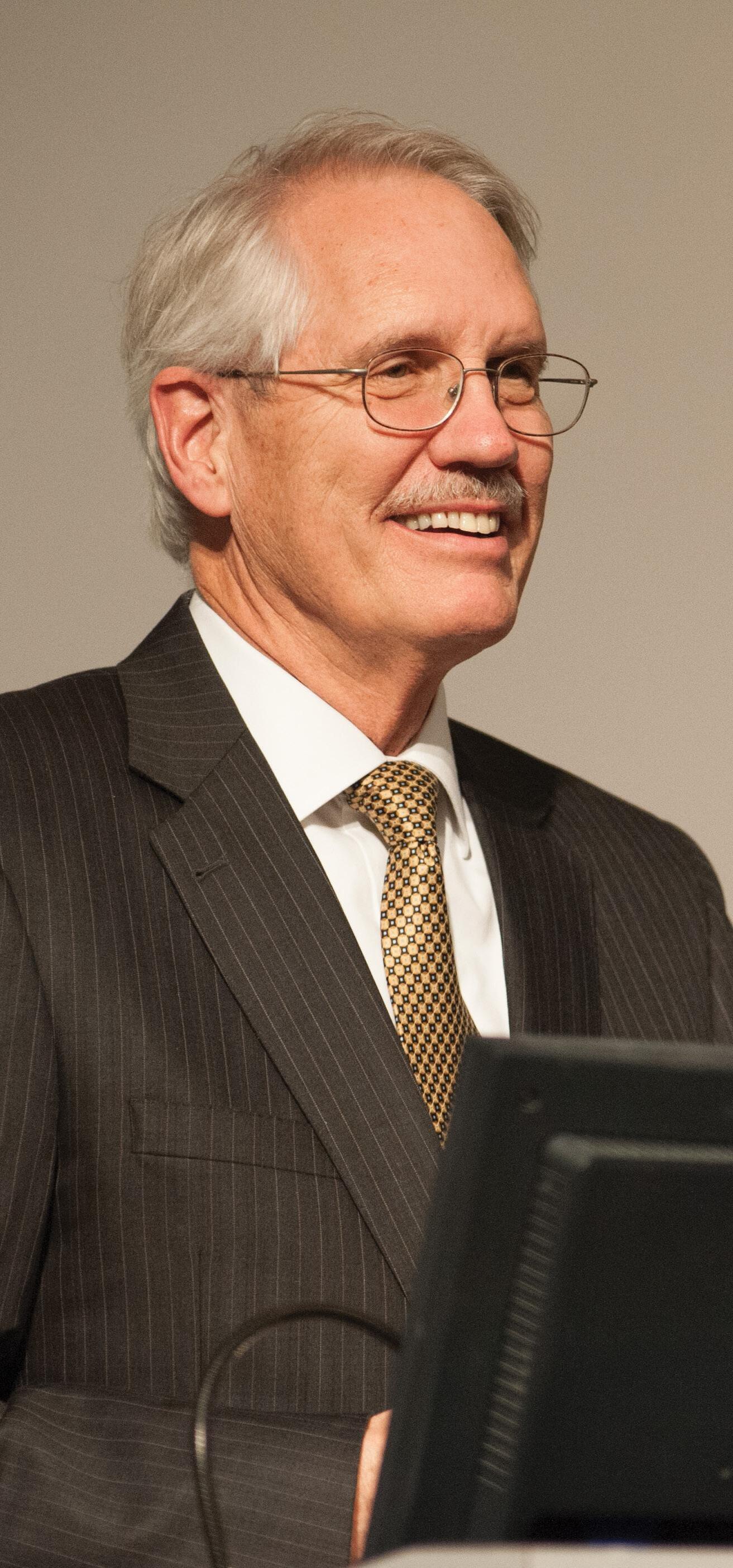
An international legacy
by JOSH VALERI
James Wertsch, the David R. Francis Distinguished Professor, retires from Arts & Sciences with a legacy of international, interdisciplinary scholarship.
For James Wertsch, WashU is a community defined by civility and collaboration.
“More than any university I’ve seen, we are capable of getting our high-powered faculty together to deal productively with people who are far outside our normal boundaries,” he said.
When Wertsch began his WashU career in 1995 as chair of the Department of Education, he wasted no time sharing his expertise across Arts & Sciences. He would go on to teach in several departments and programs, including anthropology, psychological and brain sciences, education, and global studies.
Chancellor Emeritus Mark S. Wrighton, who started at WashU the same day as Wertsch, soon took notice of his leadership abilities. “He was quite a diverse intellectual,” Wrighton said. “Over time, I became aware of him as a truly outstanding member of our faculty.”
In 2005, Wrighton asked Wertsch to become the founding director of the McDonnell International Scholars Academy, an initiative designed to position WashU as the anchor of a global community of universities. Wertsch went on to travel internationally with Wrighton, securing funding and partnerships for the initiative.
“At the time, there was no other institution in the U.S. that had this kind of program,” Wertsch said. “The idea was to bring young people from different disciplines and parts of the world together for cohort experiences. They would travel together, think together, educate each other, and expand their horizons.”
MEMORIES & MILESTONES 20
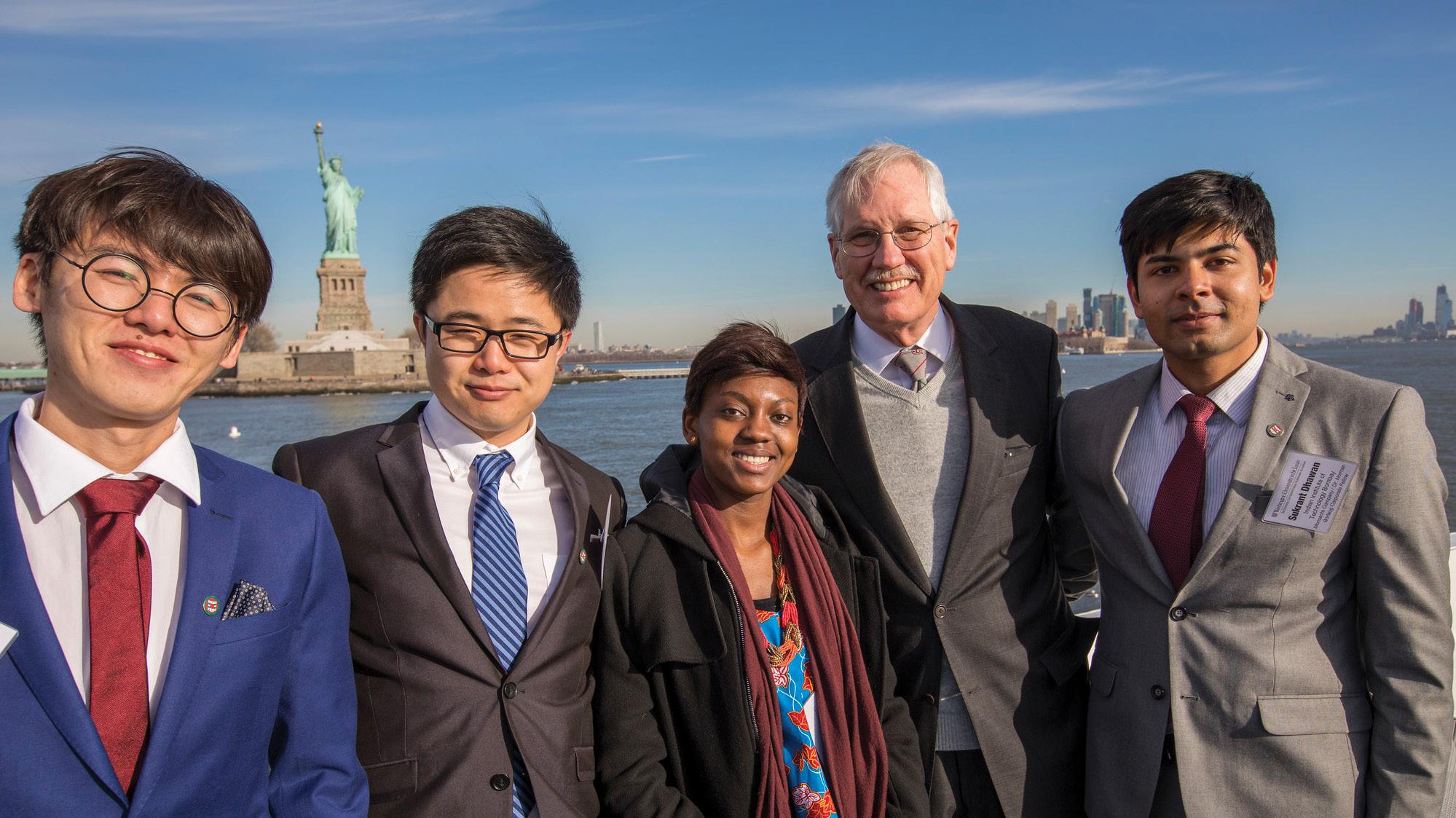
Today, the McDonnell Scholars program has nearly 100 scholars from more than 40 international universities. According to Wrighton, Wertsch played a crucial role in its development. “Jim and his wife Mary were tremendous in terms of hosting events and engaging the McDonnell Scholars during their time of leadership,” he said. “His spirit of intellectual engagement will be missed.”
For Wertsch, leading the McDonnell Scholars program was a natural extension of his academic work, which consistently emphasized the importance of interdisciplinary, international collaborations. The value of this work first came into focus during Wertsch’s postdoctoral study in the Soviet Union in 1975, shortly after he earned his PhD in educational psychology from the University of Chicago. In Russia, he encountered a fundamentally different approach to psychology than what he had seen in America.
While Americans tend to focus on the minds of individuals independent of society, he said, it’s exactly the opposite in Russia. “To Russians, we are not individuals until we have internalized a lot of social discourse, starting from birth.” In other words, psychology cannot be fully understood without a deeper study of arts and sciences.
Wertsch went on to write extensively about the need for an interdisciplinary approach to American psychology. At the
same time, he became interested in a broader question: Why did Russians and Americans think so differently?
His most recent book, “How Nations Remember: A Narrative Approach,” draws from multiple disciplines to examine how nations become stuck in different ways of thinking and remembering, and how this can lead to international conflict. Wertsch said initiatives such as the McDonnell Scholars program present an important solution to these international differences.
“After watching students in that program, I’m a very deep believer that you need to have settings where young people from around the world can meet long enough to trust each other and then have productive learning experiences where they look at each other and say, ‘Wait, how can you possibly think that?’”
In retirement, Wertsch plans to continue work on an international project about collective memory and national narratives with colleagues including Henry “Roddy” Roediger, the James S. McDonnell Distinguished University Professor of Psychological & Brain Sciences. He will move to Washington, D.C., to collaborate with think tanks on various projects and, most importantly, to spend time with his grandchildren.
The Ampersand | Spring 2024 21
A spring break trip to New York City is a highlight of the McDonnell Scholars program. The traveling scholars have the opportunity to enhance their leadership skills and grow their professional networks.
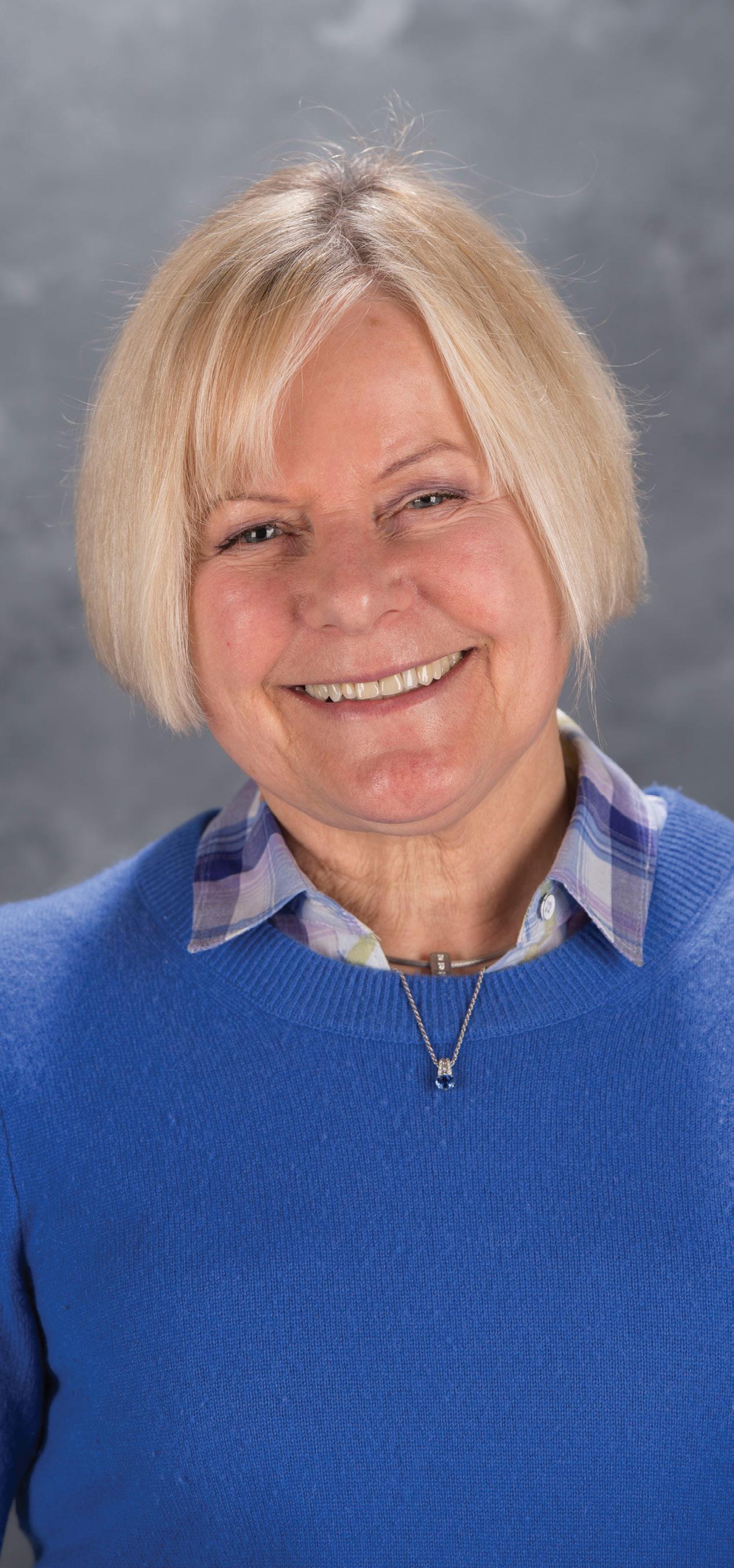
Communicating with history through literature
by JOSH VALERI
Gerhild Williams, the Barbara Schaps Thomas & David M. Thomas Professor in the Humanities, concludes a tremendous career of leadership, community-building, and scholarship.
Gerhild Williams has experienced firsthand the importance of nurturing WashU’s community spirit. “The people that surround you always have plans and dreams,” she said. “You participate in theirs and they participate in yours. It's always a give and take.”
Throughout her 48-year career at WashU, Williams sought to support all members of the university community through her roles as vice provost, associate vice chancellor for academic affairs, and chair of the Department of Germanic Languages and Literatures. In the eyes of Chancellor Emeritus Mark S. Wrighton, her efforts were a success. Williams consistently dismantled barriers and facilitated action between different parts of the university, he said.
“Gerhild has been a tremendous advocate for faculty,” Wrighton said. “People will not always be as direct with the chancellor as they would with a faculty colleague, but Gerhild was very good at communicating input from other faculty members.”
When Williams arrived at WashU in 1975, she had just received her PhD in comparative literature from the University of Washington, Seattle. Along with an appointment in the Program in Comparative Literature, she eventually became director of linguistics studies and of medieval and renaissance studies, as well as chair of the Department of Germanic Languages and Literatures.
MEMORIES & MILESTONES 22
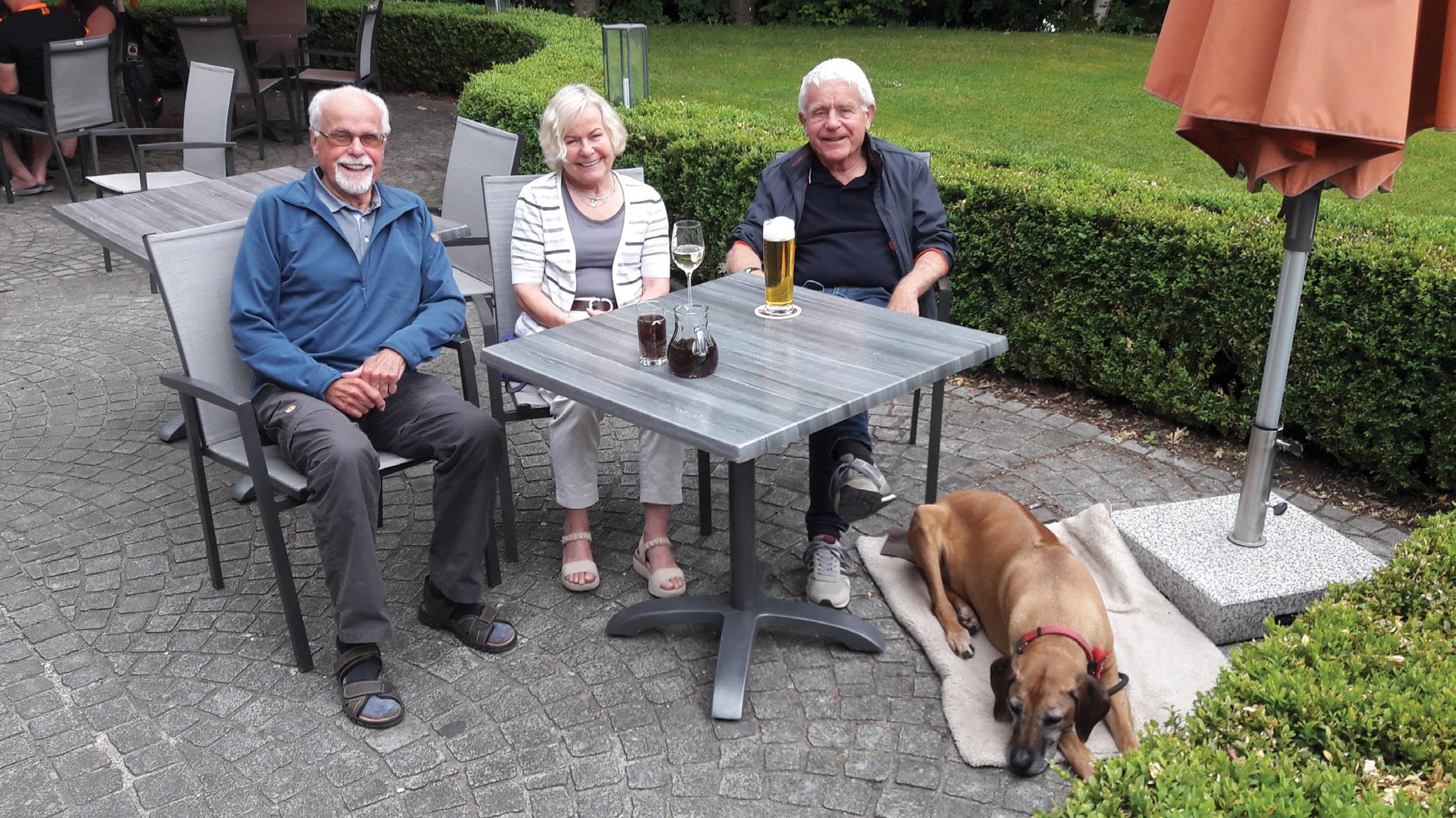
“I never wanted to leave WashU. It was the perfect place for me,” Williams said. “Our German department was, and still is, one of the best in the nation, so I always had excellent colleagues and students. And there was a very cooperative community between the administration, the faculty, and the students. That's why I could be so productive — I was supported from all sides.”
Some of Williams’ proudest accomplishments centered around creating a more inclusive culture at WashU. She helped found the International Writers Center, which, for 10 years, was directed by William H. Gass, and she more recently supported the establishment of the international writers track in comparative literature. She co-chaired a committee that passed a university-wide sexual harassment policy, voted to promote faculty diversity, and supported former College of Arts & Sciences Dean James E. McLeod’s creation of the John B. Ervin Scholars Program.
Provost Emeritus Edward Macias, who worked closely with Williams for more than 30 years, emphasized her unfailing commitment to the university and her support for colleagues. “She was a very loyal team player, yet she was always willing to express her opinion on important issues, even if it went against the conventional wisdom,” he said. “She cared about people — her students, her colleagues, and, most of all, her family.”
As a scholar, Williams was interested in the historical impact of cross-cultural communications. She began her career as a medievalist, tracing how poetry crossed the Mediterranean to Spain, France, Germany, and England. She published on the early modern witch phenomenon and, most recently, on the 17th-century novel.
Williams traveled through the centuries in her research, analyzing how German and French literature and culture changed in response to historical developments. She became especially interested in the profound impact of newspapers in the 17th century, a time when they began to appear regularly in Germany. This early “social media” went on to broaden communication across Europe, she said.
In her work, Williams has traced the impact of historical “social media” on the development of the novel and the spread of witch trials, among many other subjects. These studies, she said, have felt especially relevant given our current struggles with modern misinformation.
After she retires this spring, Williams plans to finish transcribing a three-volume collection of tales by the 17thcentury writer Erasmus Francisci. She looks forward to remaining connected to friends and family in St. Louis, traveling and hiking through Germany with her brothers, and cross-country skiing in Sweden.
The Ampersand | Spring 2024 23
In retirement, Gerhild Williams is looking forward to traveling across Germany with her brothers. Last summer, the siblings went hiking in Bavaria.
An Arts & Sciences Guide to Hip- Hop
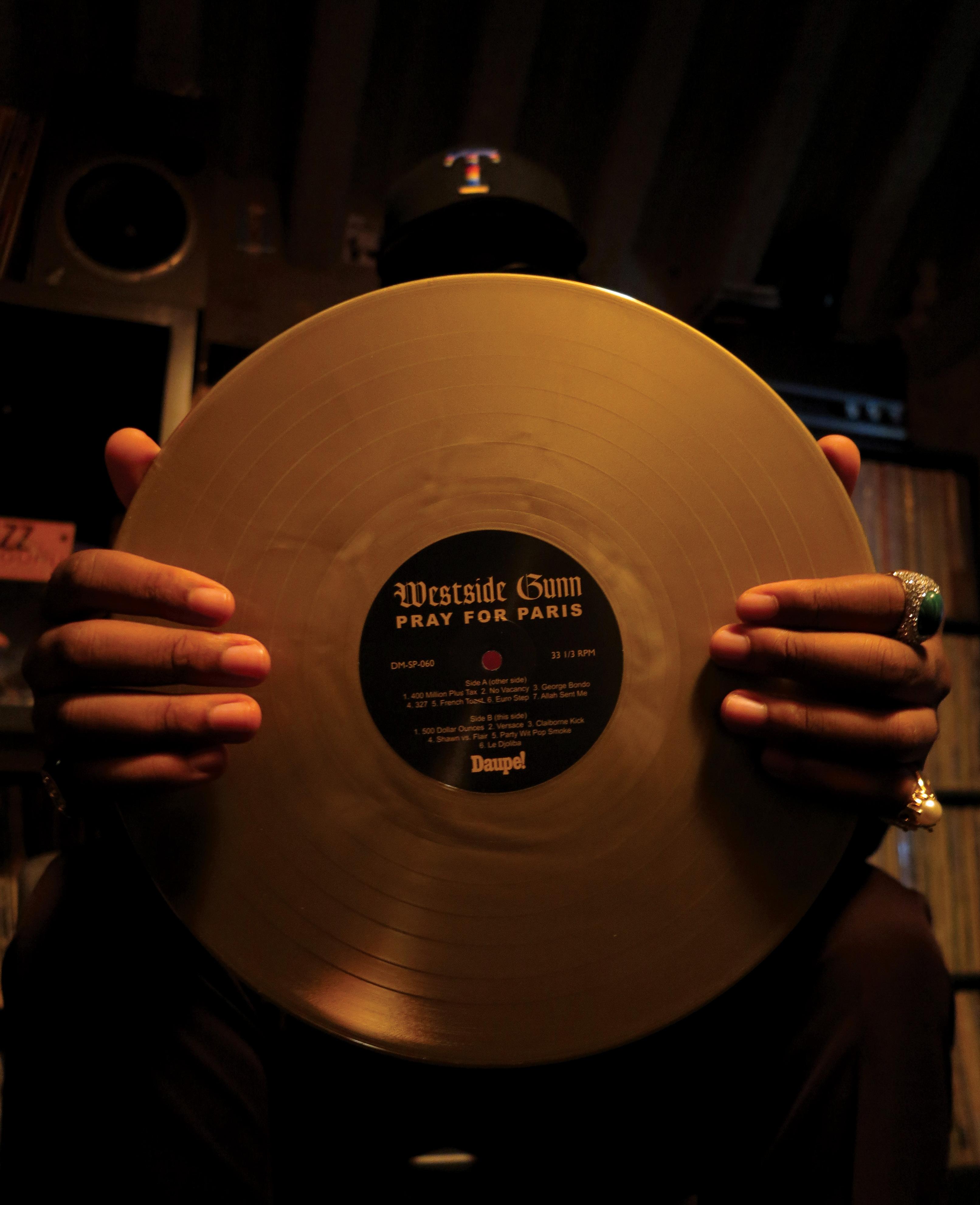 by JENNY BIRD
by JENNY BIRD
Faculty members Jonathan Fenderson and Zachary Manditch-Prottas are uniting students from diverse disciplines in a rigorous study of hip-hop and rap, the predominant music of their generation.
(Photos: Sean Garcia)
FEATURES 24

In the 50 years since hip-hop debuted on the music scene, it has moved from outsider art to a dominant force in popular culture, influencing everything from fashion to language to visual art. College students today don’t know a world without it.
In their course “Beats, Rhymes & Life: A Cultural History of Hip-Hop,” Jonathan Fenderson, associate professor of African and African American Studies, and Zachary Manditch-Prottas, lecturer in African and African American Studies and American culture studies, guide students through the world that shaped the music. They examine the rhythms, lyrics, and historical context behind the music and attempt to understand what the rise of this genre means for society today.
“Before Zach came to WashU, I hadn’t had any intellectual partners around rap,” Fenderson said. “I realized this can be a rich, rigorous conversation that forms the basis for cutting-edge work.”
As the two talked, they began to see how the subject might make for an appealing course for students across Arts & Sciences who are hungry to perform deep, interdisciplinary analysis. It also formed the basis for an Ampersand program, “50 Years of Hip-Hop,” which allows first-year students to study the topic for two semesters and travel to New York in the spring.

Learn more about Ampersand programs. artsci.wustl.edu/AmpersandPrograms
The course "Beats, Rhymes & Life" encourages students to apply a range of artistic and scientific questions to hip-hop and rap, fostering new insights across disciplines.
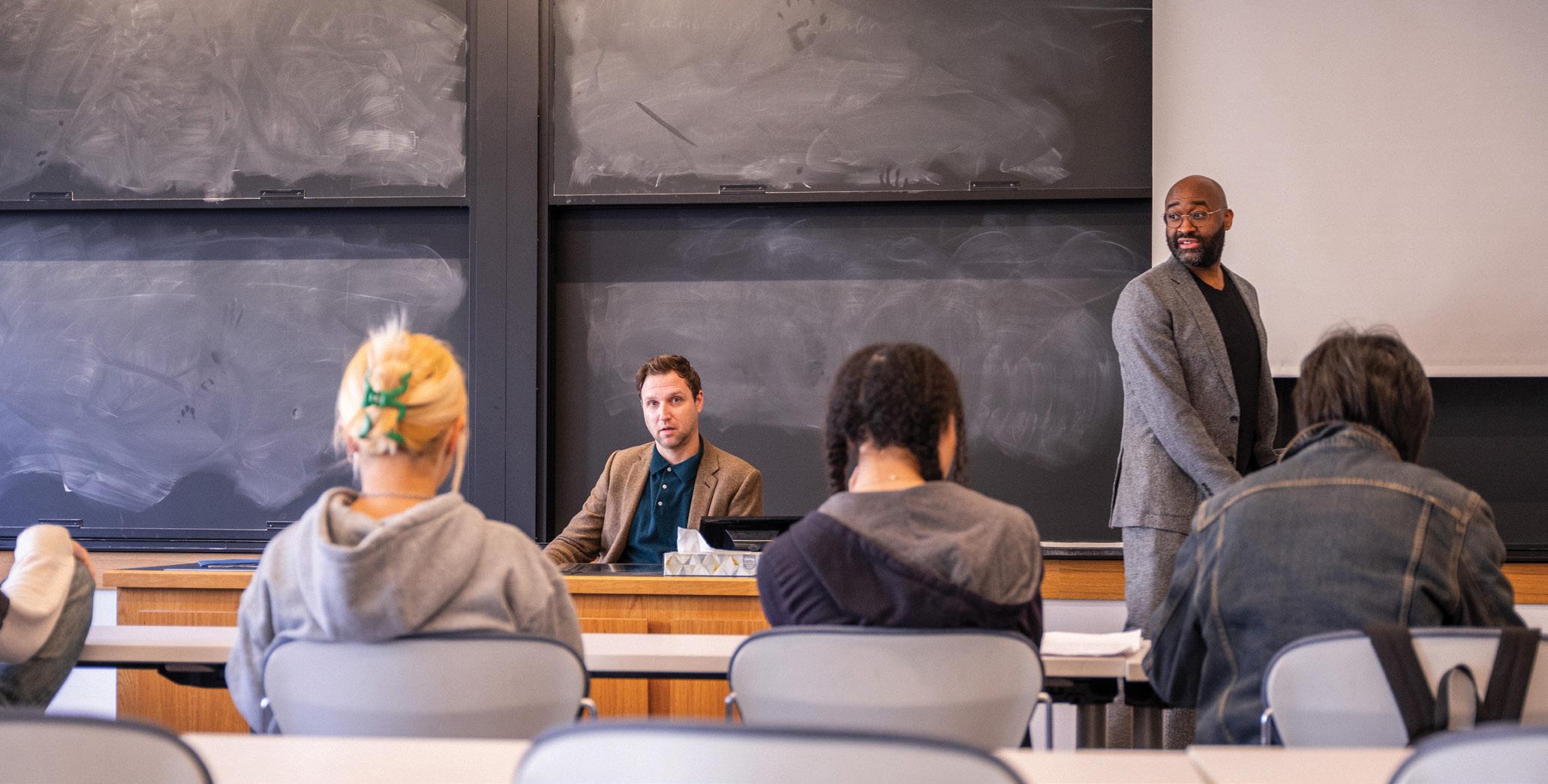
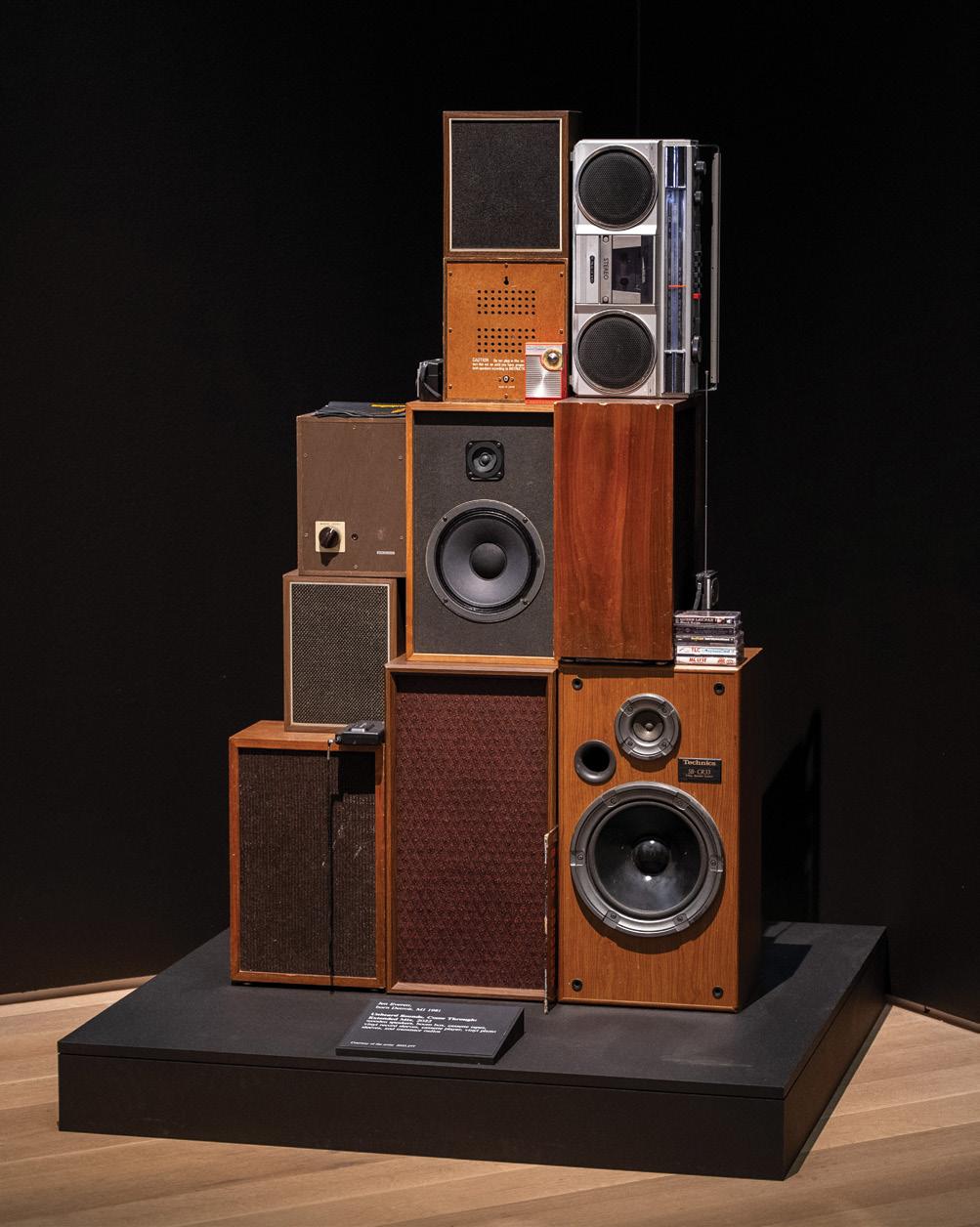
Like the music they examine, Fenderson and ManditchProttas are a study in contrasts. Fenderson is from the West Coast; Manditch-Prottas comes from the East Coast. Both are African and African American Studies professors, but Fenderson works more like a traditional historian with an emphasis on archival work while Manditch-Prottas specializes in literary, gender, and sexuality theory.
The 35 students in their course also come from diverse backgrounds. Some are dedicated fans of the music while others signed up with little knowledge of the genre or its context. “The range of entry points is what makes the conversation so dynamic,” Fenderson said. “People are coming with their own interests.”
The seminar-style course encourages students to apply a range of artistic and scientific questions to a shared topic, fostering new insights into a genre that, for many, is part of daily life.
“This is complicated, boundary-breaking music,” ManditchProttas said, “and the students take it very seriously.”
 Lecturer Zachary Manditch-Prottas (left) and Associate Professor Jonathan Fenderson (right) guide students through the world that shaped the music.
Lecturer Zachary Manditch-Prottas (left) and Associate Professor Jonathan Fenderson (right) guide students through the world that shaped the music.
artsci.wustl.edu/HipHop
Watch students discuss their experiences in "Beats, Rhymes & Life."
FEATURES 26
A sculpture on display at the Saint Louis Art Museum exhibition "The Culture: Hip Hop and Contemporary Art in the 21st Century."

The Scientist: Ron Fishman
Growing up in New Jersey, Ron Fishman would put on headphones and listen to rap his entire bus ride to middle school. It was his daily escape, comfort, and safe space, he said. Music has always been important in Fishman’s life thanks to his family — his grandmother was a music teacher and his father raised him on a steady diet of Beatles records — but as a first-generation American raised near New York City, rap was the music that resonated.
He was scrolling through the WashU course catalog last year when he saw “Beats, Rhymes & Life.” Now a senior biology major with a focus on neuroscience, he viewed the course as an opportunity to consider his favorite genre through a new academic lens.
Fishman is interested in how individual perception — a response based in the brain — changes a person’s reaction to a song. Scientists looking at brain activity on a functional MRI can see highly specialized regions of the brain illuminate when someone recognizes a face, for instance. But watch
the brain activity of someone listening to rap, Fishman said, and it “lights up like a Christmas tree.” The auditory cortex engages to process tone. The prefrontal cortex is triggered to integrate and interpret emotions. If the music generates feelings such as nostalgia, the amygdala and hippocampus get involved. When we listen to something as complex and layered as hip-hop, he said, “the brain merges emotion, memory, and hearing all at the same time.”
But Fishman's interest in hip-hop isn't limited to neuroscience. Thanks to his joint interest in social sciences — he’s pursuing a minor in medical humanities — Fishman is also fascinated with the cultural side of the music. The active discussion and debate in the course have changed his understanding of many songs and artists.
“There are so many bright kids in the class from all over, all studying different things,” Fishman said. “I’ve had my eyes opened on certain issues, especially when it comes to hyper-masculinity and gender dynamics in the music. It has deepened my knowledge about how the genre interplays with politics at large.”
The Ampersand | Spring 2024 27
Senior Ron Fishman combined his passion for rap with his interest in neuroscience.
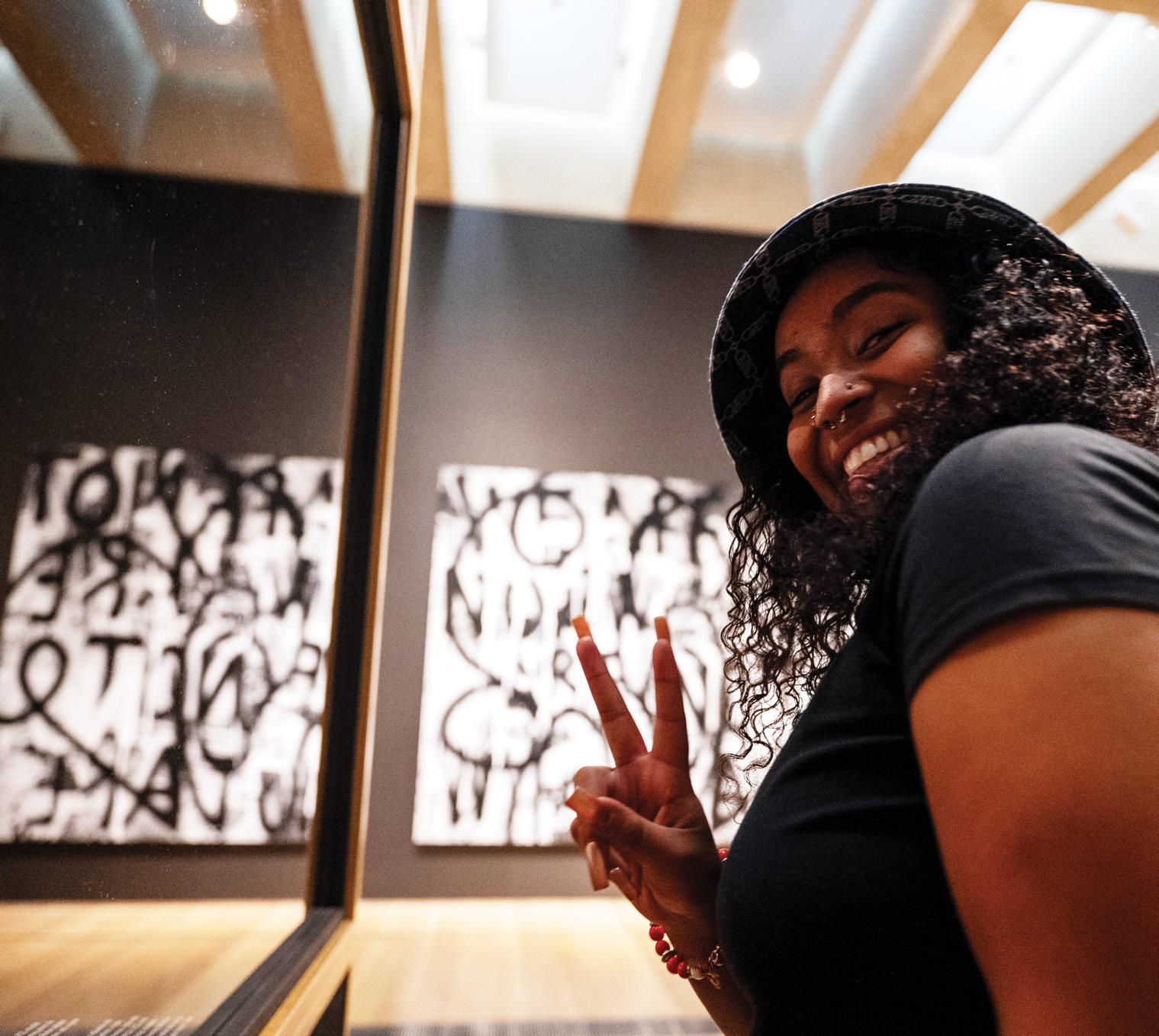
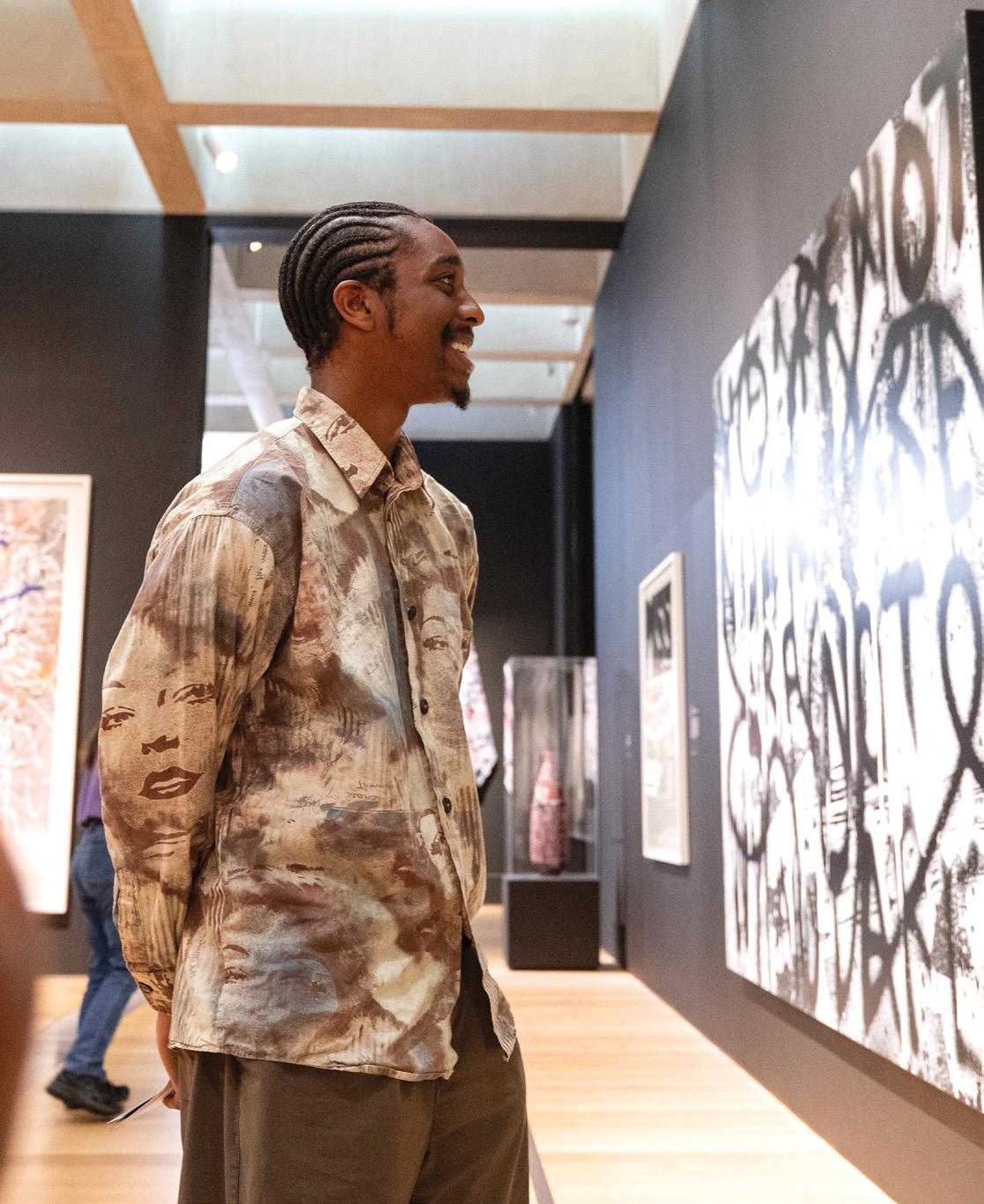
The Black Studies Scholars: Maya Phelps
and Hady Sow
Maya Phelps and Hady Sow, seniors majoring in African and African American studies, welcomed the chance to apply a more intellectual lens to their favorite genre of music.
The themes of hip-hop can often seem heavy — poverty, trauma, and marginalization — but Phelps and Sow said the music is about so much more. "Black communities created this music to find joy amid structural violence by the state,” Phelps said. “Hip-hop emerged not only as a way to share their experiences but also as a cathartic, communal art form."
For Sow, a Bronx native, rap is tangible art. “Rap has been the soundscape of my life,” he said. The course has offered him a chance to consider the wider social and political context of the genre. He points to parallels between the music and political events taking place in the U.S. when the genre took root at the end of the 20th century, a challenging time for members of the African diaspora living in New York City.
“These songs express frustrations and lived experiences,” Sow said. “Some do that directly with lyricism, others use rhythm. But they all seem to chip away at some kind of social commentary.”
Phelps, a Mellon Mays fellow, studies the intersection of gender and race, which sparked her interest in understanding how Black women and queer people contributed to the genre. “Rap is positioned as male-centric, but so many women have paved the way,” she said, pointing to pioneers such as Roxanne Shanté, Salt-N-Pepa, MC Lyte, Foxy Brown, and Lil' Kim. The class has also given her the chance to turn an analytic eye toward some of the foundational songs of the genre. “A song can be looked at through a critical lens even if it’s canon,” she said.
For Phelps and Sow, rap and hip-hop are valuable vehicles to examine the lives of people who have often been overlooked in academia. “When it comes to Black people’s experiences in the U.S., this music is their reality, rooted in their actual lives,” Phelps said. A pop culture lens is a legitimate way to examine history, she added, allowing the people being studied to speak with their own words.
FEATURES 28
Students in the hip-hop course, including Maya Phelps (left) and Hady Sow (right), attended the Saint Louis Art Museum exhibition "The Culture: Hip Hop and Contemporary Art in the 21st Century."
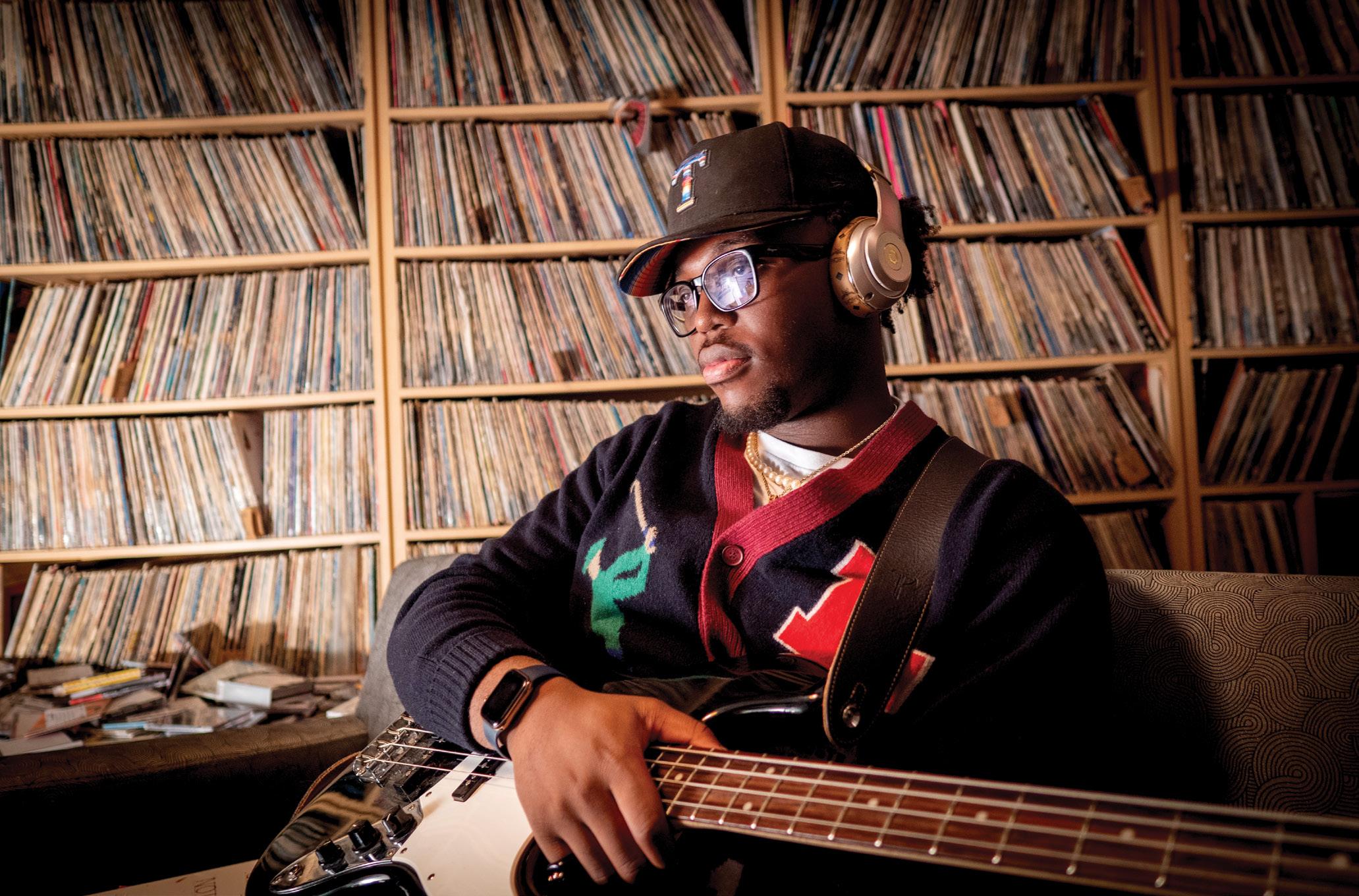
The Musician: David Oseni
For David Oseni, a sophomore majoring in philosophyneuroscience-psychology, “Beats, Rhymes & Life” has been a way to stay connected to art while pursuing his dream of becoming a doctor.
“As a pre-med student, classes can get overwhelming,” he said. “This class is a way for me to balance my STEM-heavy course load and have an area to completely vent and express my creative passion.”
In his first year at WashU, Oseni took a course on the music of the African diaspora, tracing it from Africa to the Caribbean and, eventually, New York City. Fenderson’s and Manditch-Prottas’ class picks up where that course ends.
Oseni said the discussions in “Beats, Rhymes & Life” allowed him to participate in a wider cultural analysis of the genre. “Hip-hop was formed through community, created by people in the Bronx coming together to listen to songs, hear DJs scratch, and create new musical techniques during a time of disparity and violence,” he said. “The music was the
foundation for people to come together, to use music as a path to joy.”
That’s how music works in Oseni’s life, too. He’s also a jazz guitarist who produces and mixes music in his free time. “Rhythms can express how you feel, and producing them is a really powerful way to do it.”
And while he initially signed up for the course as a counterbalance to his science studies, there’s been some surprising overlap with his major. Last year, the course “Technology & Selfhood” had Oseni considering music’s impact on relationships and emotions. Later, in an introductory psychology course, he learned how a parent’s genomes affect their child’s hearing, a lesson he thought about in the hip-hop course when they discussed the subjective experience of listening to a song.
“Beats, Rhymes & Life'' has brought into sharper focus the significant role hip-hop has played in both Oseni’s life and society. “Music is everywhere, and it is much more profound than a collection of 12 notes,” he said. “It is a means of motivation and expression."
The Ampersand | Spring 2024 29
David Oseni is a jazz guitarist who produces and mixes music in his free time. The hip-hop course helped him stay connected to art while he pursued a science-heavy course load.
SNAPSHOT
Sunsets –and science – at sea
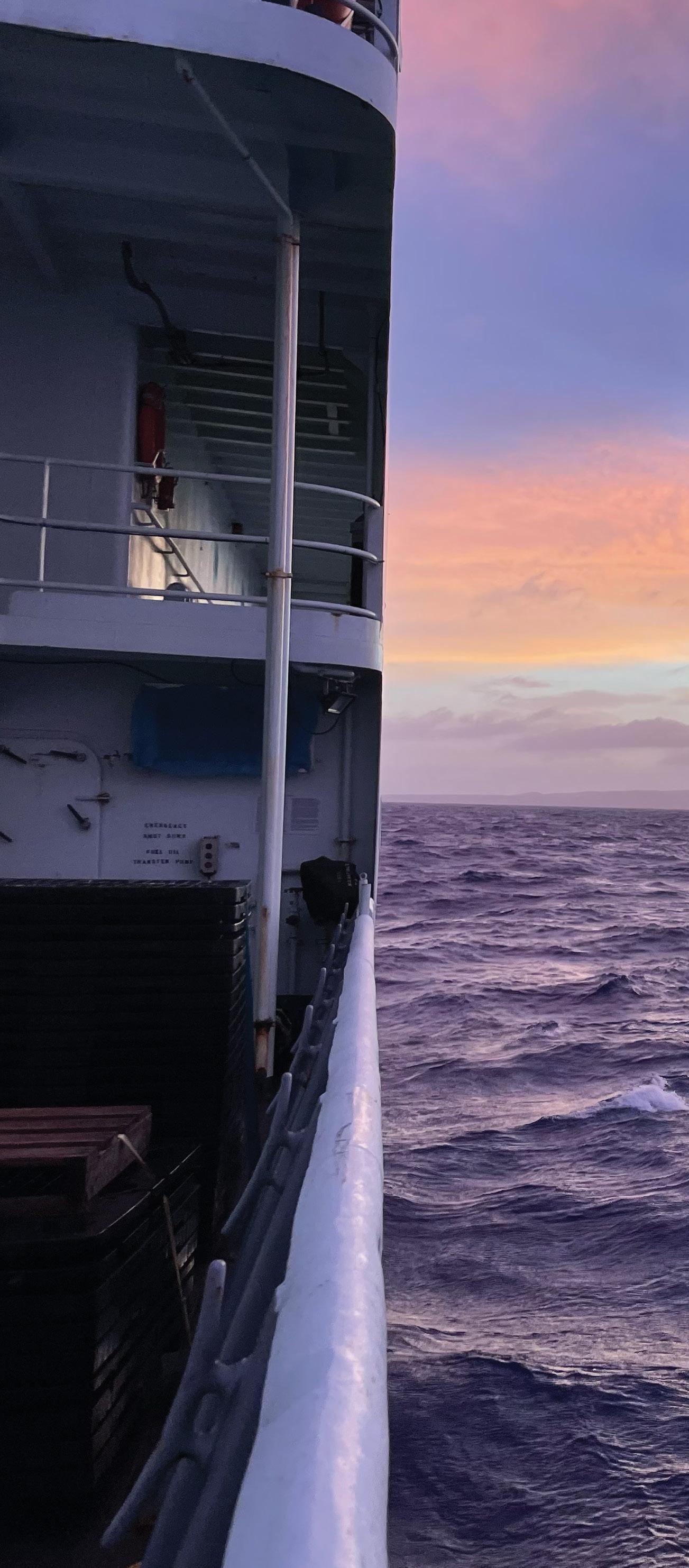
During their 28-day research cruise from Samoa, Professor Doug Wiens and graduate students Adrea Williams and Judy Zhang saw dozens of incredible sunsets from their floating home, the R/V Thomas G. Thompson. They also got firsthand experience deploying ocean-bottom seismographs and dredging lava samples from the sea floor. Wiens, the Robert S. Brookings Distinguished Professor, served as chief scientist on the cruise, which was a National Science Foundation-funded collaboration with researchers from Michigan State, UC Santa Barbara, and the Scripps Institution of Oceanography. Some of the samples the team recovered will be analyzed in the lab of Rita Parai, assistant professor of Earth, environmental, and planetary sciences.

30

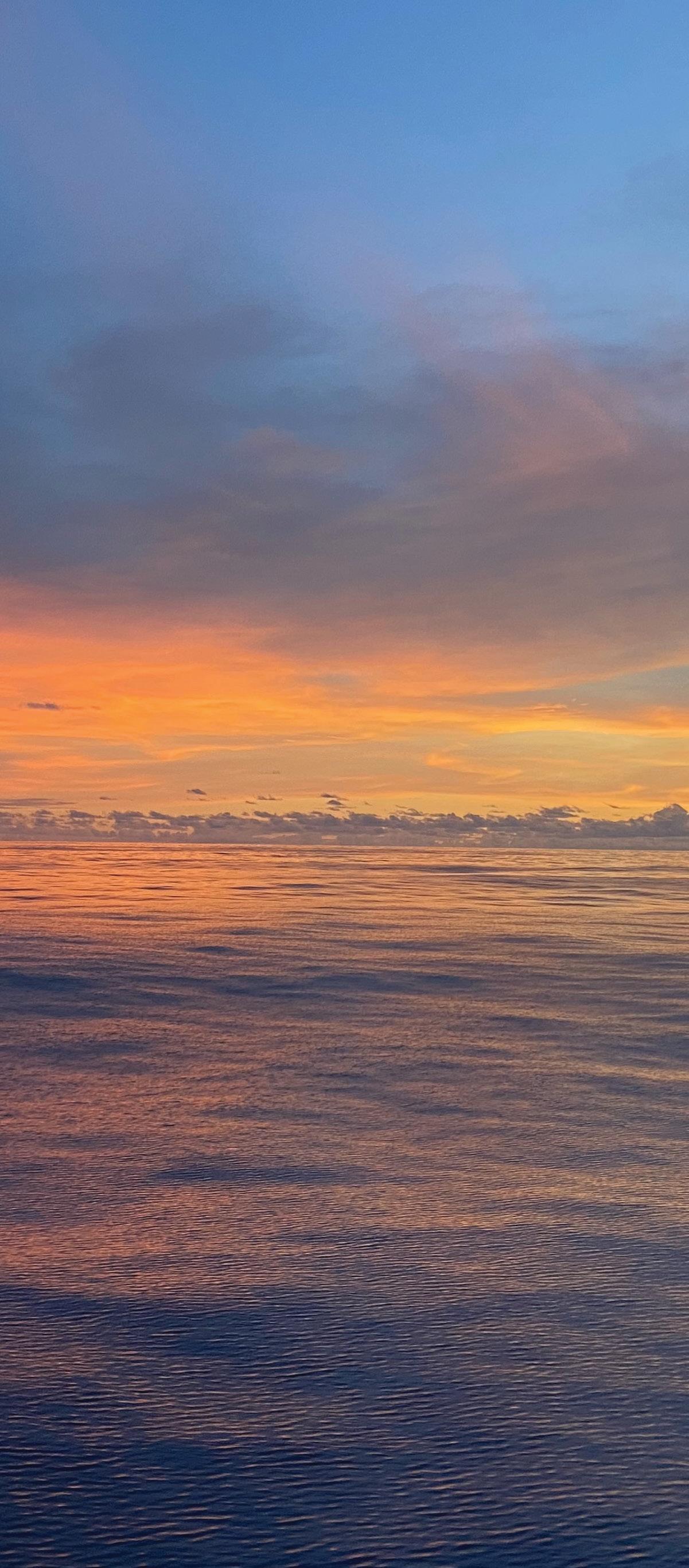
The Ampersand | Spring 2024 31
(Photos: Doug Wiens, Adrea Williams, Judy Zhang)
Unlocking the secrets of the human brain
Researchers in The Department of Psychological & Brain Sciences are using cutting-edge techniques to help us weather the challenges of everyday life.
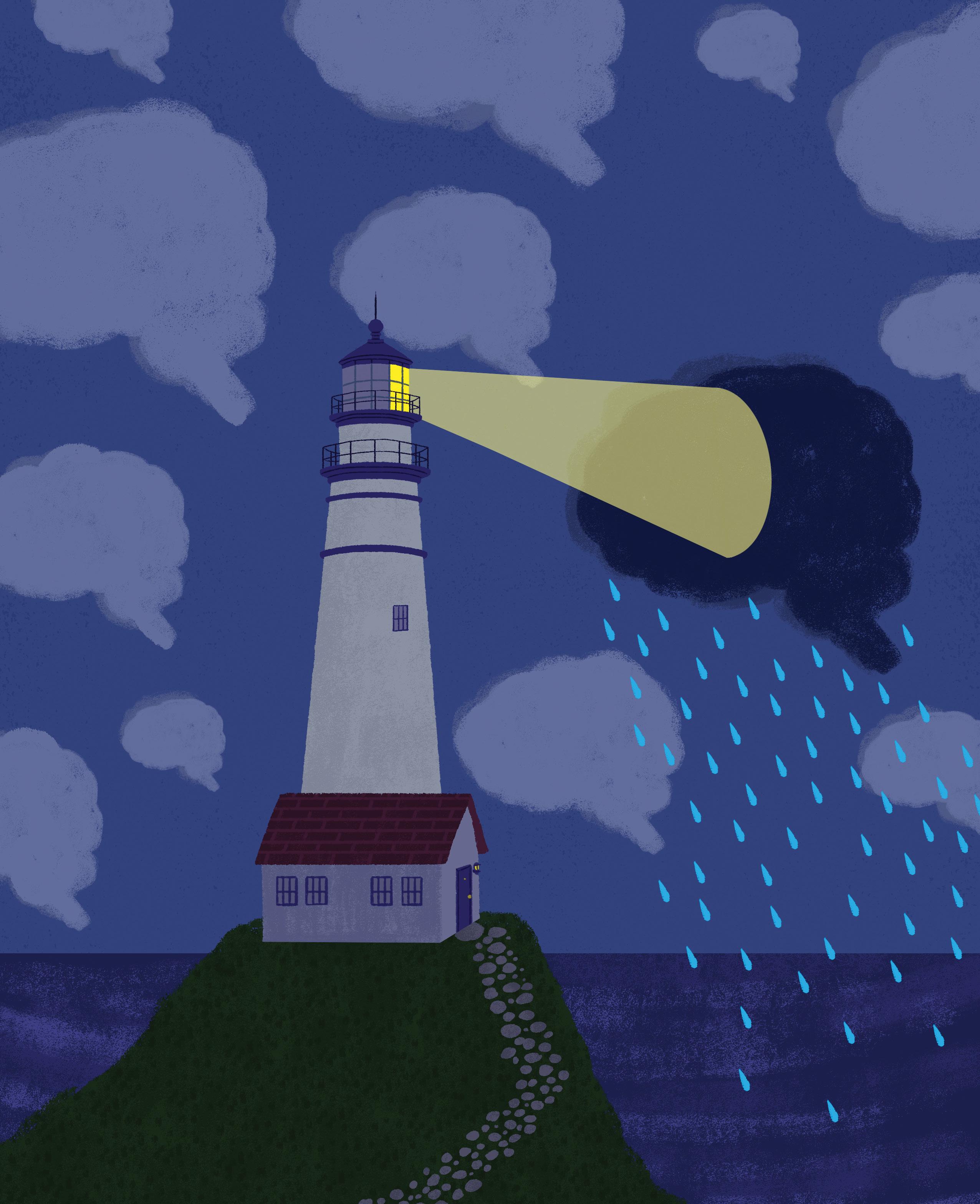 by CHRIS WOOLSTON (Illustrations: Daniel Fishel)
by CHRIS WOOLSTON (Illustrations: Daniel Fishel)
FEATURES 32
Human behaviors and emotions can be as complex as any force of nature. From our biggest life choices to the subtle thoughts we barely notice, our minds are always at work.
Inspired by the thoughts and emotions that drive our everyday lives, faculty in the Department of Psychological & Brain Sciences (PBS) are finding new ways to study the mind. From leveraging the power of cell phones for real-time monitoring to deploying sophisticated imaging techniques to better understand brain activity, this nationally recognized department is pushing scientific boundaries in a major way.
“Our field is very dynamic, with new theories and methods coming online every day and broadening our view of the human condition,” said Jeff Zacks, department chair and the Edgar James Swift Professor in Arts & Sciences. “Increasingly, we’re going outside of the lab and into the brain.”
This multifaceted approach has paid off. In the last year alone, PBS researchers have published a slew of attention-grabbing studies covering topics including our surprising motivations for morality, the stark rural-urban personality divide, and the mental maps we build to navigate our world. “The department is going in a lot of exciting directions,” Zacks said.
Arts & Sciences researchers have the motivation, resources, and opportunities to gain new insights into human thoughts and behavior, said Todd Braver, the William R. Stuckenberg Professor in Human Values and Moral Development.
“People go into this field because they are fascinated — and often mystified — by human behavior,” Braver said. “We’re interested in supporting each other and creating an environment where we can all do our best work.”
Mindful attention
Braver is the lead investigator of a massive project designed to study the brain’s ability to pay attention to complicated tasks — a pursuit with implications for nearly everyone.
The project is expected to last five years with a total budget of about $8.8 million from the U.S. Department of Defense. Among other things, researchers will use both functional MRI and EEG methods to study how stress affects our ability to pay attention to details.
“The Navy cares about this because their jobs often require complete focus, such as monitoring radar screens,” Braver said. But the findings will likely be relevant for a civilian population, too. “We hope it will have real, practical implications to help anyone reach their full potential.”
Other members of the multi-national team include Assistant Professor Wouter Kool and Professor Julie Bugg, both in psychological and brain sciences.
Sometimes, we also need to turn our attention inward. Many WashU researchers study and promote mindfulness, the practice of being aware of one’s emotions and physical state. Braver is a co-leader of the Mindfulness Science and Practice research cluster, part of the Incubator for Transdisciplinary Futures (ITF), a signature initiative of the Arts & Sciences Strategic Plan. Among their many goals, researchers in the cluster are trying to modernize the time-honored approach to mental wellness.
With support from ITF co-directors William Acree and Betsy Sinclair, the mindfulness cluster is developing a smartphone app that will ask people to report their mental state in real-time. The app will also have users periodically practice a two-minute exercise to encourage mindful awareness of their current mood and physical state. Follow-up assessments could see if the mindfulness exercises have any lasting impact in improving mood and awareness. “It’s a very direct way to ask how people are feeling and behaving at a given moment,” Braver said.
Examining emotions in real time
Smartphone check-ins are already playing a crucial role in the work of other PBS researchers. “This approach allows us to repeatedly survey participants in naturalistic settings, resulting in rich data sets for each individual,” explained Associate Professor Renee Thompson.
Thompson and Associate Professor Tammy English used smartphone check-ins for a 2023 study that found people with major depression worked hard throughout the day to manage their feelings — a finding contrary to what some people may expect. “This study provides evidence against the stereotype that depressed people may not be very proactive about how they feel,” Thompson said.
Thompson and English, frequent collaborators since they both joined WashU a decade ago, are currently working with Braver on a five-year, $2.8 million National Institutes of Health study to better understand how people with and
The Ampersand | Spring 2024 33

without major depressive disorder regulate their emotions and how those strategies change across adulthood.
“It’s the perfect blending of our labs,” Thompson said. “I have expertise in depression, Tammy has expertise in aging, and Todd brings in the expertise of imaging.”
The project will take a multi-pronged approach to investigating how people manage their emotions, including smartphone check-ins, clinical interviews, standardized laboratory tasks, and brain imaging. To better understand how participants manage emotions, fMRI images will be taken while participants look at emotion-inducing pictures.
“There’s a lot of evidence that emotional wellbeing tends to improve with age,” English said. “Older people often have to cope with loss and dwindling cognitive resources, but they’re able to maintain their life satisfaction. We’re trying to figure out their secret.”
Understanding how older people manage their emotions could help researchers improve therapies for patients of all ages. “Perhaps we’ll be able to find something that can help people who are suffering,” English said.
Phenomena of daily life
Zacks’s own work focuses on the different ways people perceive everyday events. He’s especially interested in how the brain arranges the often-chaotic world into a series of tidy vignettes with well-defined beginnings and ends.
“If you ask people to tell you about what's going on in their lives, they tend to list a sequence of events,” he said. “This first-person view really tells us about the machinery behind how we respond to our world, how we remember things, and how we plan for the future.” Understanding how the brain performs these tricks could potentially lead to new techniques for improved learning and memory, he added.
Zacks, Braver, and Aaron Bobick, dean of the McKelvey School of Engineering, advised PBS graduate student Tan Nguyen and Arts & Sciences senior scientist Matt Bezdek on a study that trained a computer model to observe realistic scenes of daily life, such as a person cooking and cleaning in a kitchen. “The model generated predictions about what was going to happen next, and it was always monitoring how well those predictions were working out,” Zacks said.
As the model trained on recordings of real people doing real activities, it grew increasingly accurate in its predictions. “It could understand human activity on a human scale and make intelligent guesses about what somebody was going to do next,” Zacks said.
Those insights included the ability to estimate its own uncertainty. The model wasn’t always confident in its projections, Zacks said, and when it felt especially unsure, it would reassess its approach to the scene. The brain likely takes a similar approach to the world, he said, by pausing to rethink a situation before deciding how to move forward. “This is a scientifically exciting finding that goes against our expectations,” he said.
The power of teamwork
As chair of the department, Zacks oversees a diverse group of talented faculty members with different styles and approaches. “We have a great mix of established researchers and junior faculty,” Zacks said.
Earlier this year, five faculty members received an impressive array of accolades from top professional associations. Assistant professors Jessie Sun, Emily Willroth, and Zachariah Reagh all received prestigious early-career recognition, and associate professors Calvin Lai and Renee Thompson were named fellows of the Association for Psychological Science.
FEATURES 34
The department has also grown its cohort of postdoctoral researchers over the past decade. “They have really energized our programs, Zacks said.
WashU’s culture of collaboration has played a crucial role in the department’s success. Psychological and brain sciences researchers frequently work together on projects, and they also tap into expertise across campus. For example, Thompson, English, Braver, and other researchers studying aging often work with Brian Gordon in the School of Medicine. Gordon studies how biomarkers of Alzheimer’s and other degenerative diseases, detected in blood samples, can be used to predict changes in brain function and cognition.
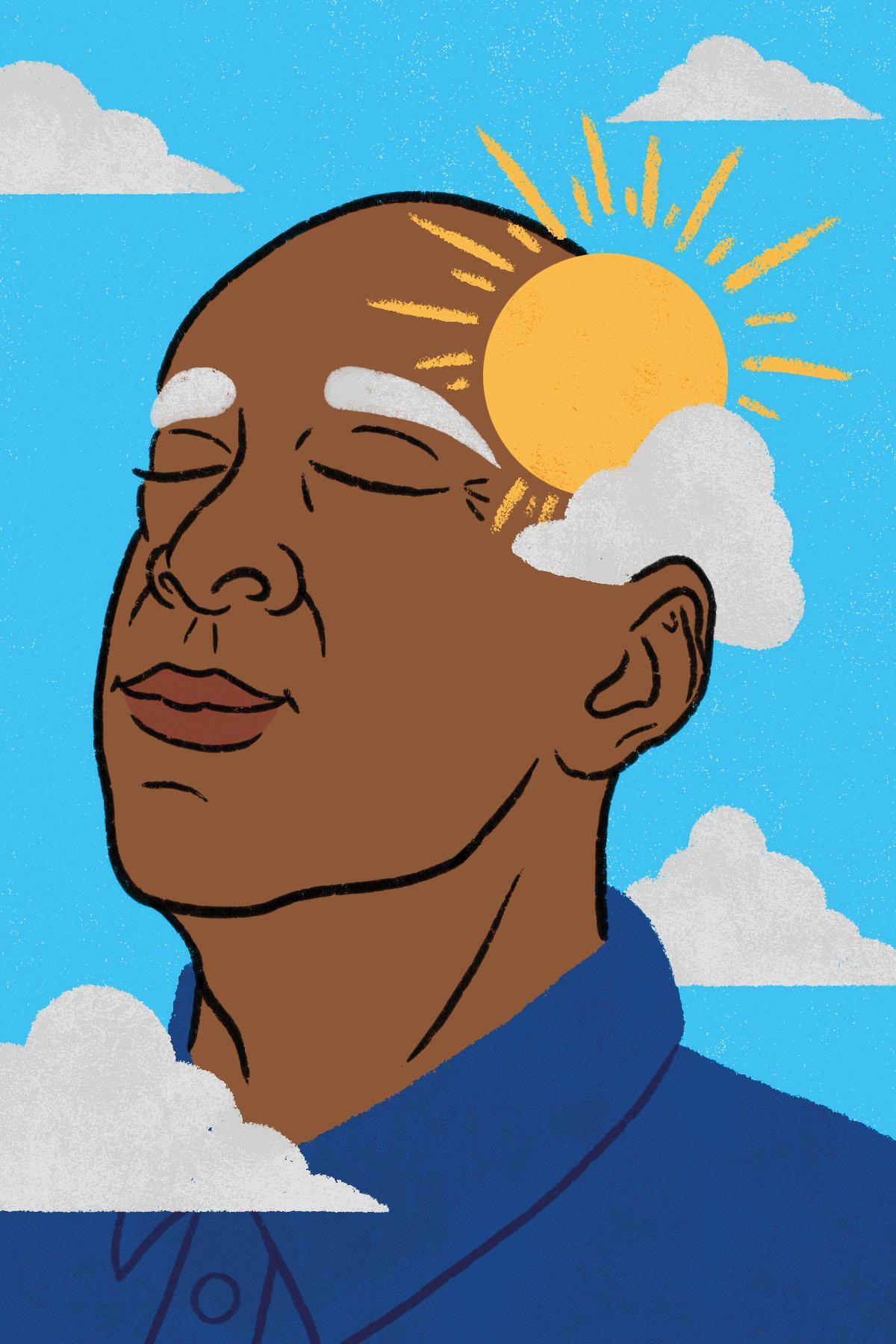
“The lore has always been that cognitive abilities inevitably decline as we get older,” Braver said. But that theory might apply only to people with neurodegenerative diseases. “If your brain is healthy and stays free from all these biomarkers, you might be able to maintain the same cognitive abilities in your 70s and 80s that you had in your 30s or 40s.”
In this and other areas of research, PBS scholars are pushing the boundaries of conventional wisdom to understand what’s going on in our brains and in our daily lives. “We’re
dedicated to the research and collection of data on cognition and behavior across the human lifespan and outside of the laboratory,” Braver said. “We’re not going to just accept simple explanations.”
Mental Notes
Psychological and brain sciences scholars published dozens of attention-grabbing studies in the last year. Here are a few highlights:
Deanna Barch
reported some infants pay little attention to frowns and other negative facial cues, an empathy gap that could have significant implications for their social and behavioral development. Professor
Associate Professor Graduate student and
Assistant Professor Joshua Jackson Amanda Wright found that five key personality traits in parents can significantly affect their child’s health, grades, and more.
Emily Willroth
conducted a study suggesting people in rural areas face unique challenges that may shape their personalities and psychological well-being.
Assistant Professor
Seanna Leath
explored the psychological benefits of an after-school program for Black teenage girls.
Postdoctoral researcher Professor and
Matt Welhaf Julie Bugg
revealed when older people let their minds wander, they’re more likely to be distracted by pleasant thoughts than worries.
Professor Graduate student and
Richard Abrams Xiaojin Ma
discovered that, in some situations, distractions can help the brain focus on a target.
The Ampersand | Spring 2024 35
Honoring exceptional alumni
Every year, Arts & Sciences recognizes a few alumni and supporters who demonstrate the ideals of a liberal arts education through their lives, work, and service. We asked this year’s Distinguished Alumni Award recipients to offer some words of wisdom and reflect on their favorite WashU memories.
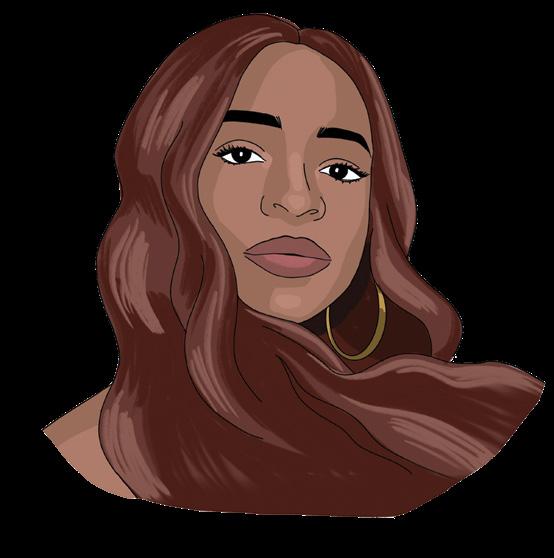
Brittany Packnett Cunningham, AB '06
EARLY CAREER ACHIEVEMENT AWARD
Packnett Cunningham is the vice president of social impact at BET Media Group, an NBC News political analyst, and the host/executive producer of the podcast “UNDISTRACTED.”
FAVORITE PROFESSOR:
I am forever grateful to Professor Rafia Zafar, who taught African American literature, for taking care of me inside and outside of class. And I have to give the biggest shout-out to Ron Himes. The idea that I could go from watching his works on stage at The St. Louis Black Repertory Company to actually learning from him in class continues to be a real highlight of my life.
THREE WORDS TO DESCRIBE WASHU: Joyful. Enlightening. Beautiful.
(Illustrations: Kristen Wang)
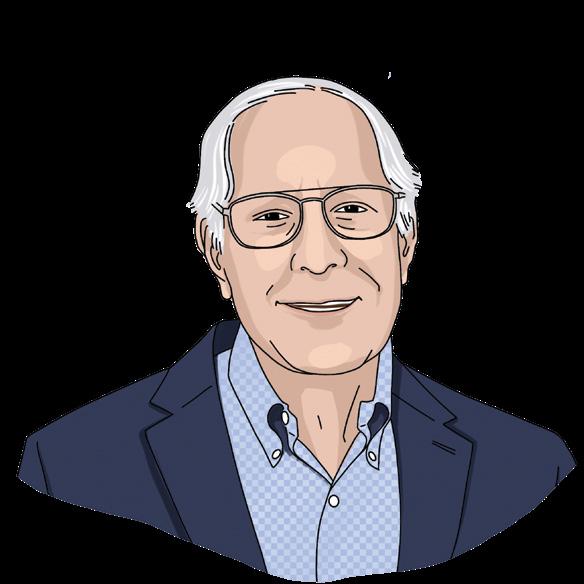
Engelsmann is a St. Louis business leader and philanthropist who, in 2023, endowed the deanship in Arts & Sciences. His father earned a bachelor’s degree in business administration from WashU in 1921, and his late wife earned a Bachelor of Fine Arts in fashion design from the university in 1965. Engelsmann, his father, and his brother founded Beltservice Corporation in 1969. The company grew to become one of the world’s leading fabricators of custom conveyor belts and a major belting wholesaler.
ADVICE TO STUDENTS:
- Grab the first opportunity that comes along. You will learn a ton. If it doesn’t become a career, it will be a valuable stepping-stone to another career.
- Always be curious. Look around every corner. You will probably find something of great value.
- Strive to do your best at every job you are given, no matter how small. You will be rewarded.
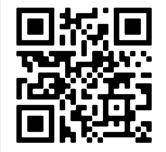
Hear more from these alumni on what inspires them and how Arts & Sciences has impacted their lives.
artsci.wustl.edu/DAA24
NOTES OF GRATITUDE
Richard G. ‘Dick’ Engelsmann DEAN’S MEDALIST
36
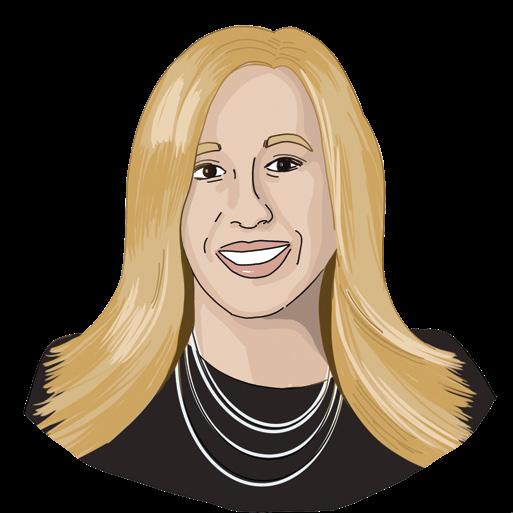
Lisa Sharkey, AB '80
DISTINGUISHED ALUMNA
Sharkey is the senior vice president and director of creative development at HarperCollins, where her team has acquired numerous high-profile non-fiction books, including more than 75 New York Times Best Sellers.
FAVORITE PLACE ON CAMPUS: Holmes Lounge, where I worked as a waitress. Back then, coffee, tea, and pastries were served. It was the place to be on campus.
THREE WORDS TO DESCRIBE WASHU: Life-changing. Invigorating. Stimulating.

Dr. Rochelle Walensky, AB '91
DISTINGUISHED ALUMNA

John C. Solenberger, PhD '69
DISTINGUISHED ALUMNUS
Solenberger retired after a decorated career at DuPont where his work in plastics led to the advancement of many modern devices. He led the development of global standards adopted by 190 nations that govern materials used in motors, transformers, and lighting.
FAVORITE PLACE ON CAMPUS:
The library. Reading the periodicals helped open my eyes to the world beyond my nuclear chemistry niche. As a result, I became more interested in the broader chemistry possibilities that major corporations offered.
ADVICE TO STUDENTS:
As you go through life, you will be amazed at what happens to you and where you will go. Always remember: In change there is opportunity!
Walensky is an infectious disease clinician who has served as director of the Centers for Disease Control and Prevention, a professor of medicine at Harvard Medical School, and chief of the division of infectious diseases at Massachusetts General Hospital.
BEST ADVICE AS A STUDENT:
Think big. I have taken that lesson with me from WashU to so many other areas from the research questions I ask to the opportunities I seek.
FAVORITE CAMPUS TRADITION:
Thurtene Carnival. In college, you have amazing social interaction with your peers, but you don't always see kids or see society. Thurtene is one of those places where you actually do.
The Ampersand | Spring 2024 37
Emma Lembke goes to Washington
by SARAH HUTCHINS
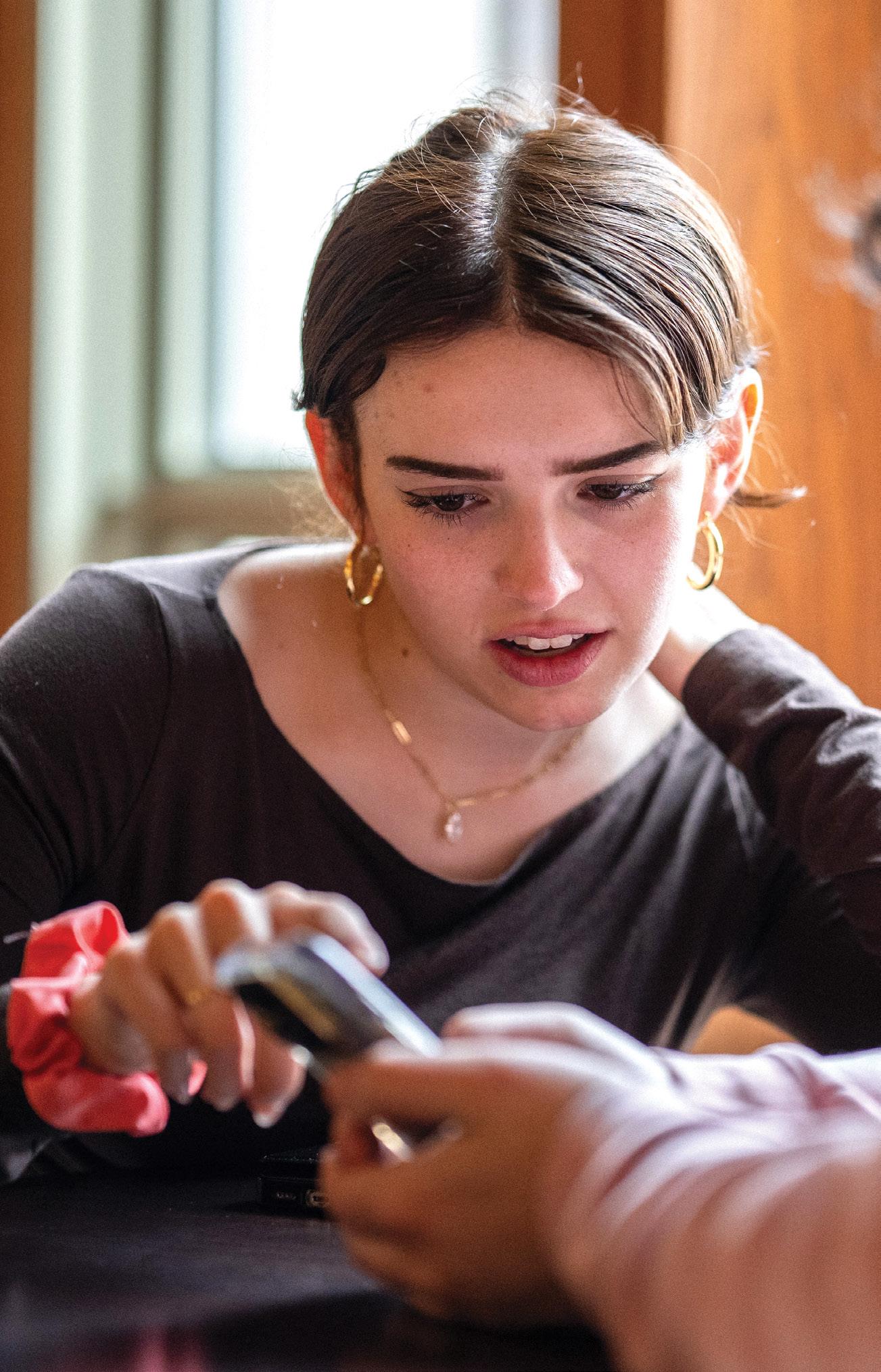
When Emma Lembke got her first social media account — Instagram — at age 12, it didn’t take long for her to realize the seemingly magical platform had a darker side. “After a few months, I realized it was more like a mirage,” Lembke said. “Social media is a platform that’s predicated on maximizing my attention at the cost of my well-being.”
As a high school senior, Lembke founded Log Off, a nonprofit to help young people develop healthy social media habits. What started with a basic website soon snowballed into a global movement, national media appearances, and invitations to testify before the U.S. Senate Judiciary Committee and visit the White House.
Lembke sat down to discuss her decision to go to WashU, the benefits of a liberal arts education, and how she juggles activism and coursework.
How did you come up with the idea for Log Off?
In the ninth grade, I reached a breaking point with social media. I did a lot of research, and while I found robust information on social media’s impact on young people and humanity, what I couldn't find were the voices of young people themselves. I thought that was an incredible injustice.
At its core, Log Off is a mechanism to help young people build better, healthier relationships with technology by centering them in the conversation and empowering them to be activists. I hope that will eventually lead to voting and holding Big Tech accountable.
What led you to WashU?
Log Off completely altered my trajectory. Initially, I wanted to study archaeology and Egyptology. But when I was applying to schools, I looked for programs with flexibility because part of me knew that if the Log Off movement continued to take off, that’s what I wanted to do. I looked for schools that valued a holistic, well-
STUDENT SPOTLIGHT 38
rounded education that would provide me with the tools I needed to be the activist I wanted to be. When I looked at WashU, I fell in love with the flexibility and the importance of engaging and connecting across disciplines to create effective solutions.
You’re a political science major, but you’ve seemingly created a custom curriculum around civic activism.
Yes, I did. “Introduction to Digital Anthropology” was one of the coolest classes I've taken. Now I'm in “Social Media and American Democracy.” I've also taken coding, statistics, and economics courses. It's this beautiful puzzle of looking at the course list every semester and asking, "What is going to help me be the most effective advocate?" It’s been exciting to figure out what that combination is going to be each semester.
How did you learn to be such an effective public speaker?
I would largely attribute it to musical theater in high school. In my first semester at WashU, I was Wednesday in the student-led production of “The Addams Family.” I’ve also taken courses in musical theater and dance, and I’m trying to get into acting. When I went to testify in front of the U.S. Senate Judiciary Committee, a prominent political figure encouraged me to take more theater classes. She said that to be an effective leader, you need to understand how to present yourself and how that presentation is affecting others.
How do you juggle Log Off with WashU coursework and being a college student?
There’s always an ebb and flow, but it’s difficult. I think what makes it worthwhile is that it never feels like a job. And because I’ve been able to curate my WashU course load, the information I learn goes right back into my activism. When I go to class, it can ebb into having a call with the Gender Policy Council because I’ve just learned something about federal lawmaking, and then I'm talking with a federal lawmaker. So, it all feels interconnected.
You were invited to the White House in 2023 to watch President Biden sign an executive order establishing new standards for artificial intelligence safety and security. What was that like?
When I got the email from the White House I thought it was a joke or a scam. I had to miss class, but I was able to go and be in a room with some of the most powerful people I've ever seen — Sen. Chuck Schumer, Vice President Kamala Harris,
President Biden. It was just a remarkable moment. I've been fighting for three years to emphasize the narrative that young people are capable of being involved in this conversation at a high level. This felt like a victory.
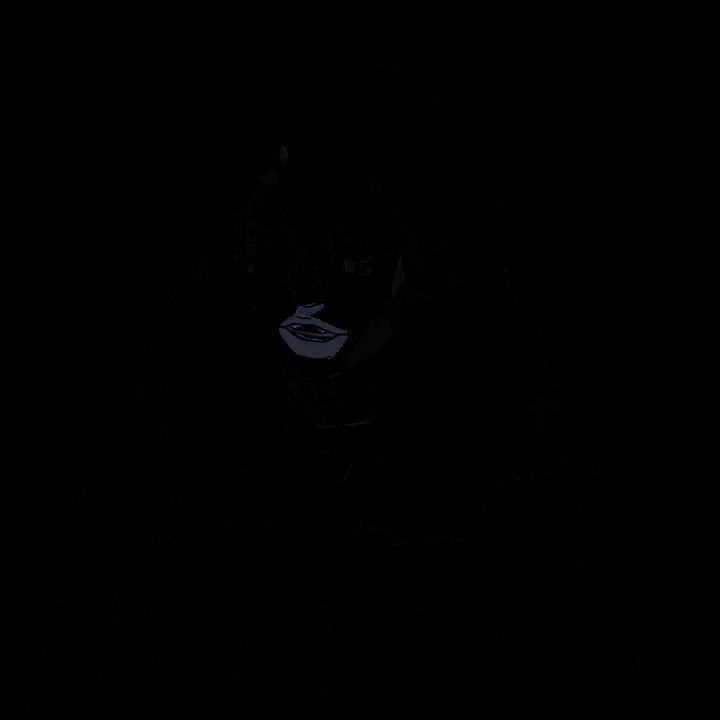
Emma Lembke
Hometown: Birmingham, AL
Year: Junior
Major: Political Science
Future plans: Earn Juris Doctor/Master of Public Policy degrees. Work at an agency protecting digital rights or the privacy of children online.
Never in a million years did I think so many people would want to engage and hear my voice. It has been an incredibly empowering experience.
The Ampersand | Spring 2024 39

A blueprint for a better workplace
by SARA SAVAT
The economic and social upheaval created by the COVID-19 pandemic and the 2020 murder of George Floyd forced a corporate reckoning. In response, many companies made bold pledges to address persistent inequities in hiring, pay, and advancement opportunities for Black workers.
In her new book, “Gray Areas: How the Way We Work Perpetuates Racism & What We Can Do to Fix It,” Adia Harvey Wingfield, the Mary Tileston Hemenway Professor in the Department of Sociology, reveals why Black workers are still underrepresented at the top ranks of most companies long after the passage of the Civil Rights Act and the rise of a multibillion-dollar diversity industry.
Drawing on her extensive research and interviews with more than 200 Black workers over the last decade, Wingfield dissects the complex dynamics that define what she calls “gray areas” — the workplace relationships, networks, and cultural dynamics that have become increasingly essential to both companies and employees.
“Gray areas determine how we learn about potential jobs, who gets serious consideration for them, how their performance is evaluated, how we advance, and more,” said Wingfield, also vice dean of faculty development and diversity.
“Too often, companies elevate diversity as a concept but overlook the organizational culture and internal processes that disadvantage Black workers,” she added.
Wingfield’s recommendations span leadership practices, organizational policies, and interpersonal strategies, providing a road map for fostering workplace equity and addressing gray areas head-on. By weaving together realworld examples and analysis, she brings to light the lived experiences of Black employees and encourages readers to reflect on their own experiences and biases.
“In identifying and addressing these gray areas, we have the greatest opportunity to transform our workplaces into environments that truly serve all employees.”
Adia Harvey Wingfield offers readers a deeper understanding of the subtle “gray areas” that can make or break our quest for racial equity at work.
FACULTY BOOKSHELF 40
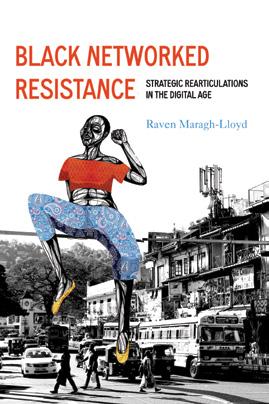
Department of African and AfricanAmerican Studies
Black Networked Resistance: Strategic Rearticulations in the Digital Age
Raven Maragh-Lloyd

Department of History
The Social Topography of a Rural Community: Scenes of Labouring Life in SeventeenthCentury England
Steve Hindle
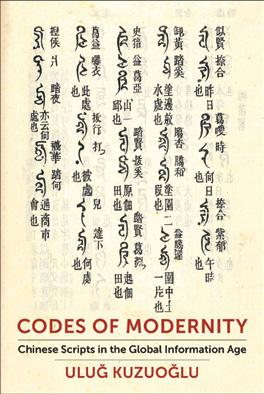
Department of History Codes of Modernity: Chinese Scripts in the Global Information Age
Ulug Kuzuoglu
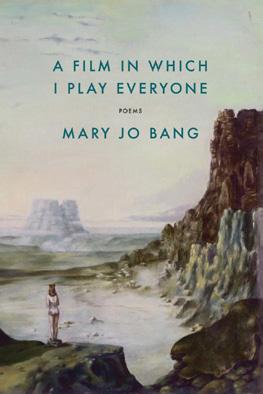
Department of English
A Film in Which I Play
Everyone: Poems
Mary Jo Bang

Department of Jewish, Islamic, and Middle Eastern Studies
Exile and the Jews: Literature, History, and Identity
Edited by Nancy E. Berg and Marc Saperstein

Program in Film and Media Studies
Technology and the Making of Experimental Film Culture
John Powers

artsci.wustl.edu/FacultyBookshelf
The Ampersand | Spring 2024 41
more
the digital Arts & Sciences faculty
Browse
books on
bookshelf.
Science for all
WashU’s chemistry chair shares a formula for scientific innovation creating a culture where diversity thrives.
by JEN HEEMSTRA
As the leader of one of WashU’s world-class science departments, it should come as no surprise that chemistry is an essential part of my job. But I’m not only talking about the study of chemical bonds. The 19 people in my lab — myself and 18 talented students and postdoctoral researchers — all have bonds of our own. We come from different parts of the world — Africa, Asia, Europe, the U.S. — and have different personalities, interests, and working styles. We also occasionally have disagreements and conflicts, which is exactly the way it should be.
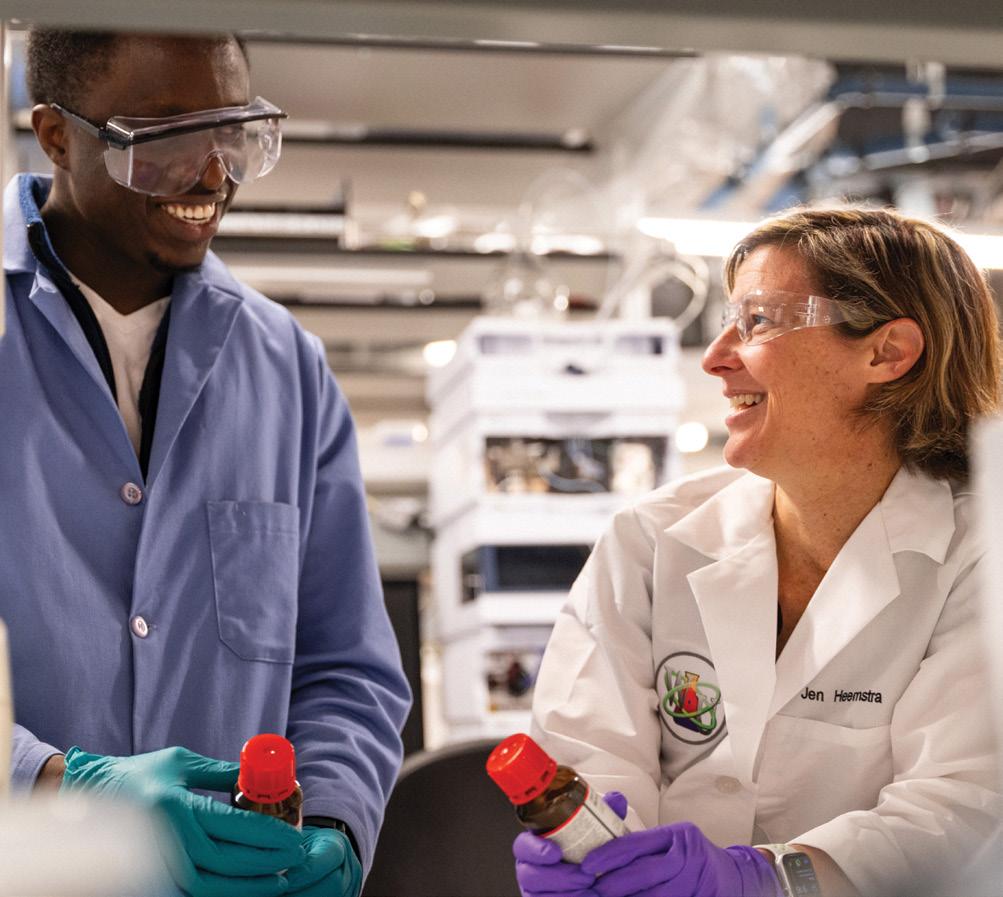
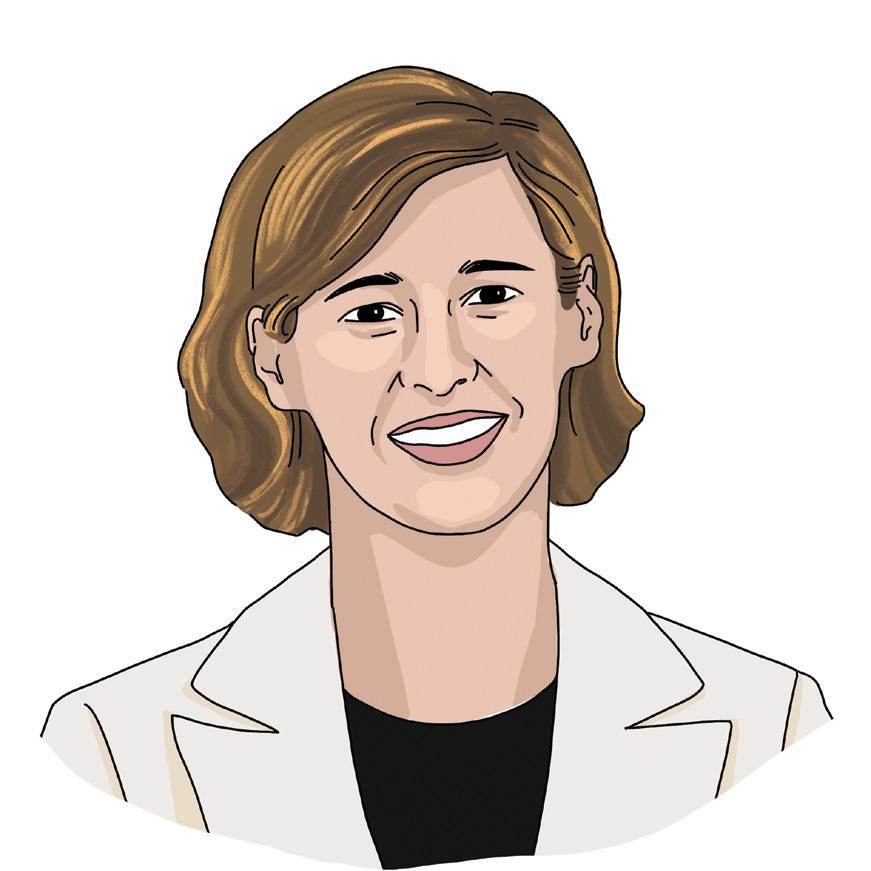
We’re trying to answer novel questions and develop new technologies. No single person has all the knowledge or intuition needed for this research, which means we must work as a team. Simply put, science thrives in diversity.
When I talk about diversity, I’m always attuned to identities such as race, gender, nationality, sexuality, disability, and socioeconomic status. It’s vitally important to recognize the challenges faced by members of underrepresented groups. At the same time, diversity can take other forms that contribute to effective teams. These include diversity of life experiences, scientific backgrounds, and approaches to problem-solving. To propel cutting-edge research and innovation, we need everyone to contribute.
Embracing diversity goes beyond assembling a diverse team. As lab leaders, scholars, and members of a university community, we must also build a culture where everyone has a voice and a chance to thrive. This, in turn, takes leadership skills. For many, our formal training has focused exclusively on our academic discipline, but we can all embrace a few basic principles to eliminate barriers and create a healthy workplace culture.
One of the first steps is to recognize the playing field isn’t level for everyone. We live in a world where racism, sexism, and ableism make it more difficult for some groups of people to succeed than others. In a university setting, it can be easy for members of underrepresented groups to feel they don’t truly belong.
No single person can change an entire system, but there are things each of us can do to be more inclusive and welcoming. Think about how the people around you — in a classroom,
PERSPECTIVE 42
Jennifer Heemstra (right) and postdoctoral researcher Joseph Ibukun. (Photo: Sean Garcia)
office, or research lab — interact with each other. Does the dialogue aim to build up and encourage, or is it more likely to tear down and discourage? How open are people to learning from perspectives and life stories different from their own? Are people celebrating the unique aspects of others or exerting pressure to conform?
In our lab, feedback flows freely between all members of our group. The metrics of success in scientific research can often be unclear, leaving students and postdocs with the vague anxiety that they may not be meeting expectations or fitting in. My team knows where they stand and what they need to do to succeed. And their feedback is equally vital for me as a leader. I’m grateful that, over time, my group has candidly shared feedback on how I can be more effective in research discussions, more transparent in decision-making, and more supportive in individual mentoring interactions.
While I firmly believe in diversity as an ethical principle, it indisputably leads to better results. Every year, my lab gets together for a retreat where we set goals, brainstorm future research projects, and talk about lab policies. We have created a culture where diversity and (collegial) disagreements can thrive. This leads to better research ideas, which has increased our success at landing federal grants for our work.
I’m grateful to be at an institution that is at the forefront of creating change. That commitment is apparent in our institution-wide initiatives such as WashU Leads. On a personal level, I’ve had the opportunity to collaborate with university leaders to launch #MentorFirst. These groups, based on a nationwide initiative I co-founded, bring together small clusters of faculty (including me!) to discuss the experiences and challenges of leading a research group and to learn about effective, inclusive mentoring practices.
No mentor or researcher is perfect. We make mistakes. We run experiments that don’t work. We pursue avenues of inquiry that lead to dead ends. But we’ll always be stronger — and our research will be better — when we work together and create environments where everyone can thrive.
Jen Heemstra is the Charles Allen Thomas Professor of Chemistry and chair of the Department of Chemistry. Her lab focuses on harnessing the molecular recognition and self-assembly properties of nucleic acids and proteins for applications in biosensing and bioimaging. She is the author of a forthcoming book offering guidance for science lab leaders.

Help advance our mission artsci.wustl.edu/ support /WUSTLArtSci /WUSTLArtSci Connect with Arts & Sciences at Washington University artsci.wustl.edu/ PowerEvents /washu-arts-sciences @WUSTLArtSci The Ampersand | Spring 2024 43
Stargazing in St. Louis
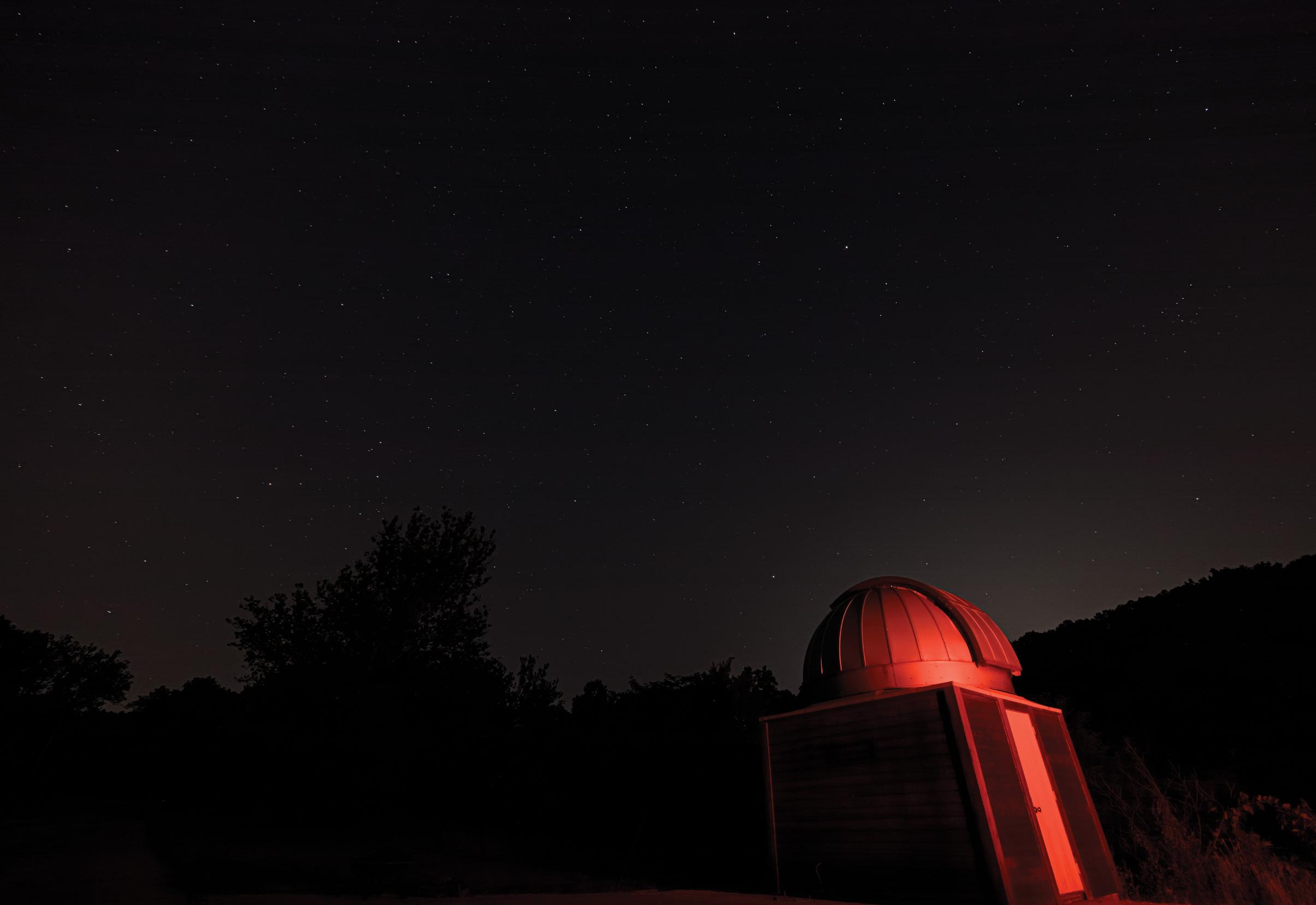
Did you know WashU maintains two of the St. Louis area's six observatories?
Danforth Campus visitors have likely glimpsed the iconic Crow Observatory, a white dome perched on top of the physics building. But for a true dark-sky experience, stargazers can arrange to travel about 20 miles from the city to the Tyson Research Center observatory, pictured here.
NONPROFIT ORG. US POSTAGE PAID ST. LOUIS, MO PERMIT NO. 1291
Campus Box 1094 | Washington University St. Louis, MO 63130-3629
CERT XXX-XXXXXXXXX FPO FPO FPO
The Ampersand is printed with the sustainability of our planet in mind.




 Feng Sheng Hu
Feng Sheng Hu
























 by JENNY BIRD
by JENNY BIRD


 Top: Veléz-Rivé (right) with her daughter, María Elisa Aguiló (left), and her twin sister Lizette C. Veléz-Rivé (center) on the WashU campus.
Top: Veléz-Rivé (right) with her daughter, María Elisa Aguiló (left), and her twin sister Lizette C. Veléz-Rivé (center) on the WashU campus.







 by JENNY BIRD
by JENNY BIRD




 Lecturer Zachary Manditch-Prottas (left) and Associate Professor Jonathan Fenderson (right) guide students through the world that shaped the music.
Lecturer Zachary Manditch-Prottas (left) and Associate Professor Jonathan Fenderson (right) guide students through the world that shaped the music.








 by CHRIS WOOLSTON (Illustrations: Daniel Fishel)
by CHRIS WOOLSTON (Illustrations: Daniel Fishel)





















